SwedishLapland

THE ARCTIC LIFESTYLE MAGAZINE culture | people | nature | taste | design
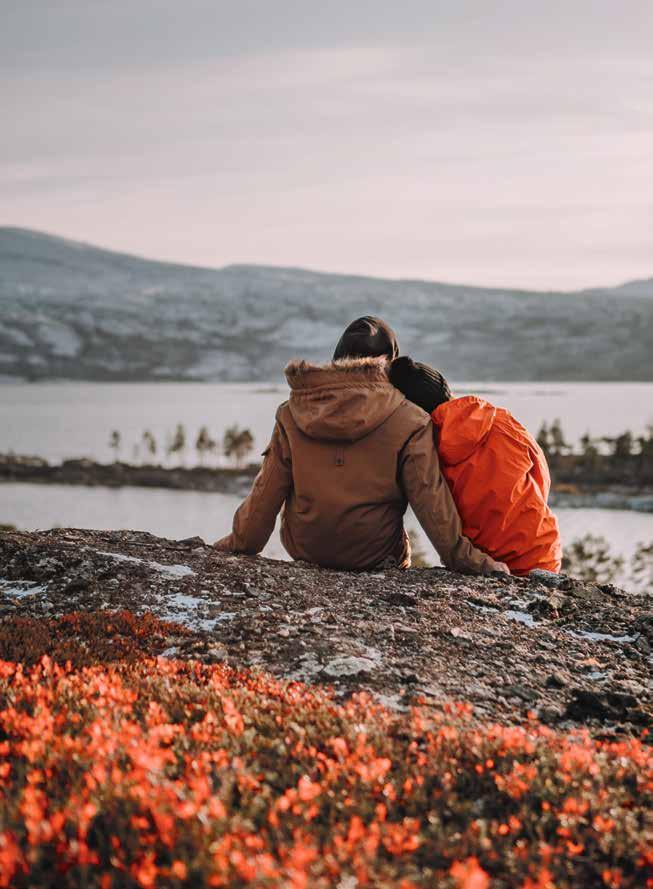
2 THE ARCTIC LIFESTYLE MAGAZINE 61° anchorage , alaska 64° reykjavik , iceland 66°arcticcircle68°abisko Photo: Me and Leila
swedish lapland
We define the destination Swedish Lapland in a hundred ways or more. For the mountains, forests and wetlands, and for the major rivers flowing continuously to the sea and the archipelago. For the people who live here and for the broad, untouched expanses of untamed nature. For the art, music and literature. For a cultural landscape and for wildlife. Naturally, our everyday arctic lifestyle also defines us as people. The seasons, distances and climate have not only dictated a special way of life, but also a life in which nature is a major aspect, almost like a religion.
Of course, for many, the geographic boundaries of Lapland, drawn by rulers many hundreds of years ago, are more important than the actual soul of the place. But what we are trying to define is an arctic soul. But what is that?

Indigenous people lived here long before a Swedish king moved the boundaries for his domain farther north. The king's men called these people Lapps, but they called themselves the Sámi and their homeland Sápmi. Sápmi is a borderless land that stretches across the entire Nordkalotten region, from northernmost Norway, over northern Sweden, into northern Finland, all the way to the Kola Peninsula in Russia.
Swedish Lapland
Sápmi
Swedish Lapland represents the Swedish part of the Arctic region, shared with six other countries: USA (Alaska), Denmark (Greenland), Norway, Finland, Russia, Canada and Iceland.
How far north is Swedish Lapland actually? For example:
• Whistler in Canada has the same latitude as Frankfurt in Germany at 50° north.
• Hokkaido in Japan has the same latitude as Rome in Italy at 43° north.
Today we also refer to this region as Arctic Europe. It is a part of the world that has become increasingly interesting for major political powers, foreign investors and oligarchs. Naturally, this destination, Swedish Lapland, is a vital part of the global fabric, but it has been shaped since time immemorial in a multicultural melting pot. Via our neighbours to the east and west – Finnish Lapland and northern Norway – we are the only part of Sweden to share national boundaries with two countries. And, somewhere at this intersection, there is something that we wish to define as a unique lifestyle. Amid the clatter of reindeer hooves, fiery sermons and weathered log cabins, something very exciting has emerged. It is an everyday arctic lifestyle deeply rooted in nature that we wish to share. We live our lives under the northern lights and the midnight sun, amid hail and black flies, wet snow and intense sunlight.
We dry our meat in the spring, smoke our fish in the summer and boil our coffee over an open fire all year round. And we put 'coffee cheese' in our boiled coffee, because we love the taste and the squeaky sound it makes between our teeth.
For us, Swedish Lapland is not really a place, but rather a way of life. And you are welcome to share it with us. /
ED.
3
SÁPMI
map
INTRO
Maj-Doris Rimpi is all that Arctic lifestyle personalised. A reindeer owner, mother, model, artist, and actress. You have probably seen her in the film Sameblod (Sami blood, 2016), and her handicraft is, of course, award-winning. In the winter, before she feeds her tame reindeer the hand-picked lichen, she will cleanse it from dry and sharp pine needles. That tells you all you need to know about this lady’s character.
PHOTO Carl-Johan Utsi

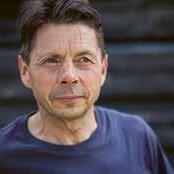
EDITOR’S NOTES
At the editorial office of this magazine, we know that we are fortunate. As we, every day, wake up at one of the best places in the whole wide world. We also know why. Thanks to all the hard-working entrepreneurs and enthusiasts, that make this place ticking. Whether it’s braving this year’s first snowstorm to take care of the reindeer herd, or staying late at night tending guests at the restaurant, working every morning to get the best local produce, or just maintaining the ski slopes – we all owe you thanks! We know that this magazine wouldn’t be possible without all your contribution and support.
This edition wouldn’t be possible either without the contribution from some of the industry’s finest. Maria Broberg and David Björkén, thanks for your words. Andy Anderson, Per Lundström, Tor L. Tuorda, Carl-Johan Utsi, Linus Granberg, Daniel Olausson, Anthony Tian, Sandra Hansson, Andreas Nilsson, Me and Leila, Cody Duncan, Viggo Lundberg, Philipp Herfort, Asaf Kliger, Linda Broström, Dan Norin, Jens Wennerberg, Anders Bobert, Graeme Richardson, Mattias Fredriksson, Tobias Hägg, Sven Burman, Peter Rosén, Pernilla Ahlsén, Thomas Larsson, Fredrik Broman, The Common Wanderer, Linnea Isaksson, Carina Forsén and David Björkén for your amazing work with the cameras. Leila Nutti and Lisa Wallin for your beautiful illustrations. Mark Wilcox and Mia Linder for spot-on translations. And Josefine Ås for a pair of extra eyes. Finally, if we hadn’t been so busy having fun, we would had finished this edition last year – so we won’t promise when the next issue will appear. But somehow it will. Until then, stay safe and see you soon.
THE ARCTIC LIFESTYLE MAGAZINE

The Arctic Lifestyle Magazine is a standalone publication, published by Swedish Lapland Visitors Board – the regional representative of the tourism industry in Sweden’s arctic destination, Swedish Lapland. Opinions expressed in this publication are those of the author, or persons interviewed and do not necessarily reflect the view of the editors.
EDITORIAL Swedish Lapland Visitors Board in collaboration with the regional network of communicators. Contact us at redaktionen@swedishlapland.com
PRINT Lule Grafiska, Luleå.
SWEDISH LAPLAND® is a registered trademark used as destination brand of Sweden’s northernmost destination. The region includes the municipalities of Arjeplog, Arvidsjaur, Boden, Gällivare, Haparanda, Jokkmokk, Kalix, Kiruna, Luleå, Pajala, Piteå, Skellefteå, Sorsele, Älvsbyn Överkalix and Övertorneå.

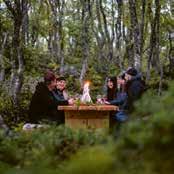
4 THE ARCTIC LIFESTYLE MAGAZINE CONTENTS
THE COVER
THE ATLANTI C NORWAY 70 42 78 94
culture people taste nature design
THE ARCTIC LIFESTYLE MAGAZINE
SwedishLapland
SWEDEN
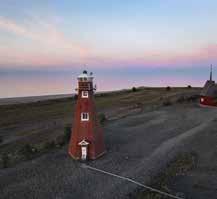
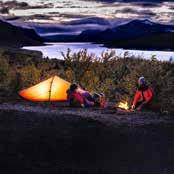



5 CONTENTS V N D E LÄ LVEN LAINIO RIVE R A R C T I C C I RCLE FI N L A N D e4 e4 PITE RIVER L ULE RIVER R Å N E RIVER K A L X R I V E R TO IV E R LAKE TORNET R ÄS K A R C H I
SKELLEFTERIVER B VINDEL RIVER MÄÄ RIVER M U O N I O R I V ER KIRUNA GÄLLIVARE ÖVERKALIX ÖVERTORNEÅ PAJALA KALIX BODEN ARVIDSJAUR ÄLVSBYN HAPARANDA LULEÅ JOKKMOKK ARJEPLOG PITEÅ SKELLEFTEÅ SORSELE 18 11 84 63 Illustration: Lisa Wallin
The places we go to
Visiting Swedish Lapland is about rich cultures and enchanting natural vistas. From the mountains to the sea, over the rolling hills deep into the wooded valleys, along ancient trails and winding roads, these are the places we go to.
FACTS:
• Laponia became a world heritage in1996.
• The world heritage consists of Sarek, Padjelanta, Stora Sjöfallet and Muddus national parks, as well as the nature reserves Sjávnja and Stubbá. The areas Tjuoldavuobme, Ráhpaäno sourgudahka and Sulidäbmá are also included.
• Laponia is approx. 9,400 square kilometres, a bit larger than Cyprus.

6 THE ARCTIC LIFESTYLE MAGAZINE SIGHTS
1
Photo: Linus Granberg
2Gammelstad church town

In 1996 the church town in Gammelstad outside Luleå was appointed a World Heritage Site by the UN agency Unesco. The red church cottages are a legacy from a time when there was an obligation to attend church in Sweden. The farmers in villages around Gammelstad church town needed somewhere to stay the night to be able to attend service. Some of them lived as far as 40 km from church, and it took time to get there, even using a horse and carriage. That is why these red overnight cottages were built and created a little town of their own. There used to be 71 church towns in Sweden and only 16 remain. Gammelstad is the best-preserved church town and as such it has a unique universal value for humanity that is worth preserving.
directions: Gammelstad is easily accessible by car, only 10 kilometres northwest of central Luleå, with signs from road 97. www.lulea.se/gammelstad
Go west
In 1996 Laponia was granted the same status by Unesco, for its outstanding universal values. Laponia is unique as a World Heritage Site because it has been appointed for its rich culture as well as its natural values. Most other World Heritage Sites are named for one of these values, rarely for both. In Laponia there is, and there will be, a living Sámi nomadic culture, and at the same time it offers one of Sweden’s most unique nature experiences. Everyone can visit Laponia – the E45 road passes through the world heritage site at the edge of Muttus national park. But above all, the Road West, BD 827 to Ritsem – sometimes known as ‘the longest cul-de-sac in Sweden’ – is a fantastic opportunity, also for the disabled, to get an insight into one of Europe’s most beautiful natural and cultural heritages.
directions: The easiest way to visit Laponia is by car on road E45 from Jokkmokk or Gällivare. www.laponia.nu
To measure the world
The Struve Geodetic Arch is the third of Unesco’s World Heritage Sites located in Swedish Lapland. But the ‘arch’ actually extends from Hammerfest in Norway down to the Black Sea. Friedrich Georg Wilhelm von Struve wanted to measure the curvature of the globe, to be able to determine its shape and size. In the beginning the chain of measuring points crossed three countries: Sweden, Finland and Russia. Nowadays the chain extends through 10 countries along its 2,820 km-long stretch. There are four measuring stations in Sweden, in Kiruna, Pajala, Övertorneå and Haparanda municipalities.
directions: Driving road 99 along Torne river, between Haparanda and Karesuando, you will pass crossroads to the stations. bit.ly/StruveKiruna
FACTS:
• 520 culture-historically valuable and protected buildings, of which 405 are church cottages.
• The unique environment consists of the 15th-century stone church with surrounding church cottages, a medieval network of streets and buildings stemming from the 17th-century burgher town.
• World heritage since 1996.
FACTS:
• The Struve Geodetic Arch runs through ten countries: Norway, Sweden, Finland, Russia, Estonia, Latvia, Lithuania, Belarus, Moldova and Ukraine.

• There are seven station points in Sweden and four of them are on the world heritage list, situated on the mountains of Tynnyrilaki, Jupukka, Pullinki and Perävaara.
• The points are marked by drilled holes in rock, iron crosses, cairns or obelisks.
• World heritage since 2005.
7 SIGHTS
Photo: Ted Logart
Photo: Dan Norin
The sculpture ‘von Struve’s Triangle’ , is overlooking Nedertorneå kyrka on the Finnish side of the Torne River. The 40 metre high church tower is one of six World Heritage measuring points in Finland.
A slow train
Inlandsbanan, the 1,288 kilometers long railway between Kristinehamn and Gällivare, is an attraction in the summer. And of course, the part running through the destination of Swedish Lapland is a high note. Stays in Sorsele, Arvidsjaur, Jokkmokk and Gällivare comes natural. On Fridays and Saturdays, in July and August, a steam train runs back and forth Arvidsjaur and Slagnäs, a perfect happening.
directions: The Inlandsbanan stops in Sorsele, Arvidsjaur, Jokkmokk and Gällivare. res.inlandsbanan.se/en
Grodkällan – the Frogs’ den
The spring Tsuobbuojája, or Grodkällan as it is named in Swedish, is situated on the bog Slengmyran not far from Lomträsk village in Arvidsjaur. The spring has been a place to visit for years. And last year the trail and the facilities around the spring were refurbished.

directions: From Arvidsjaur, take the E45 north. After Auktsjaur, follow the gravel road towards Lomträsk, and then follow the signs to the spring. bit.ly/grodkallan
The Arctic Circle
The northern polar circle is known as the Arctic Circle. Its position is 66˚ 33’ 38” N, but the truth is that the Arctic Circle moves a little bit every year because of the gravity of the Earth and the moon. You could say that the Arctic Circle is the place that defines the midnight sun and the midwinter darkness, based on the summer solstice or the winter solstice. In the destination Swedish Lapland, you cross the Arctic Circle in several places. You can swim, bike, hike or just enjoy the crossing through a train or car window.
directions: By car, you can cross the Arctic Circle just south of Jokkmokk on road E45 or 97, in Juoksengi on road 99, in Överkalix along road E10, in Jockfall on road 392 as well as in Merkenes on road 95. By train, you pass it in Murjek.
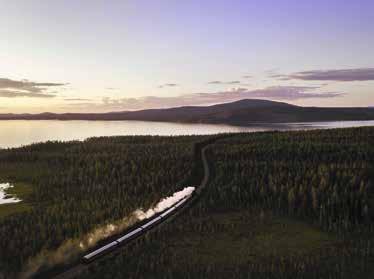
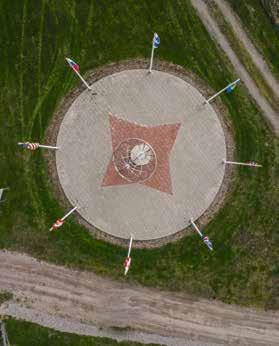
8 THE ARCTIC LIFESTYLE MAGAZINE SIGHTS
6 5
Photo: Ted Logart
Photo: Per Lundström
4
Photo: Håkan Stenlund
Storforsen rapids

The largest unregulated rapids in Europe, with a fall of 82 metres. On average 250 m3/s whirls past in the current. It is a powerful spectacle, and it is easy to understand why Storforsen is one of our most popular excursion destinations. In summer, the rapids also attract plenty of sun lovers, as the dried-up rocks heat up and some of the overflowing water creates excellent pools for bathing.
directions: Follow road 374 40 km northwest of Älvsbyn, or drive south from Jokkmokk for 100 km, first on the E45 and then left on road 374. storforsen-hotell.com
9 SIGHTS
Photo: Jens Wennerberg
7
The salmon show
The mighty Jockfall, on the river Kalixälven, is always an interesting sighting. In July, from the bridge at the fall, you have a front-row view of some of the world’s biggest salmons trying to jump the fall. Kalixälven is one of Sweden’s four National rivers. The others being Torne-, Pite- and Vindelälven.
directions: From Överkalix, drive north on road 392 along Kalixälven. When the road makes a right turn towards Pajala, just go straight on along the river. jockfall.com
The Jokkmokk market
For more than 415 years, on the first week of February, the Jokkmokk market has been a unique part of the Sápmi experience. People from all corners of the world meet here, but above all relatives and friends from the geographically dispersed Sápmi meet up. Ask anyone in Jokkmokk and they will tell you that with regard to the market there is a before and an after. It is the real beginning and end of the year. The market showcases the best Sápmi has to offer in terms of culture and design. You do not want to miss the art exhibition at Sámij åhpadusguovdásj, the handicraft exhibition at Ájtte, the inauguration, the meat soup at Akerlunds and the Sámi Duodji exhibition, and more.

directions: In the town of Jokkmokk. jokkmokksmarknad.se
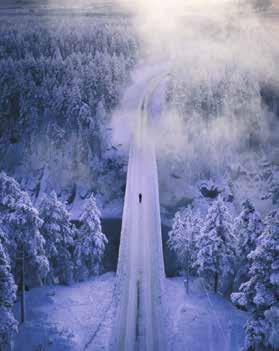
An iconic silhouette
uonjávággi or goose valley, if translated from northern Sámi language, is Sweden’s most iconic landmark. The u-shaped valley, south-east of Abisko, is the most photographed scenery of the north. The valley, a remain of the last ice age, immediately draws attention to itself, with a classic silhouette.
directions: Go by train or car, from Abisko towards Kiruna, to enjoy this iconic view. Or just sit down in the restaurant at Hotell Fjället in Björkliden. bjorkliden.com/en

10 THE ARCTIC LIFESTYLE MAGAZINE SIGHTS
Photo: Per Lundström
8 9
Photo: Tobias Hägg
Photo: Carl-Johan Utsi
10
THE GRAFFITI of gentleness
She celebrates her 40 th anniversary as an artist, Sámi narrator Britta Marakatt-Labba. This is also how long it has taken Swedes to discover her art. The breakthrough was international for this resistance artist who tells her story with the needle as a brush.

11
PEOPLE
TEXT & PHOTO: HÅKAN STENLUND
the needle powerfully penetrates the white cloth, almost like a skier moving across untouched snow where poles and skis sink into the newly fallen snow to slowly create a pattern. The skier – or the needle – slowly embroiders Sámi history. Huts and snowmobiles, shamans and deforested land, reindeer and humans, the mundane and the mythical, good and evil. Everything finds its place in Britta Marakatt-Labba’s embroidery.
Today, as we meet her in her home in Övre Soppero, she has just returned from a European trip. Despite 40 years of diligent work, it took an international breakthrough to get noticed in Swedish cultural life. An international breakthrough at the same time as other artists in Sámi contemporary life were given more space too. With people like Anders Sunna and Sofia Jannok, the film Sámi Blood and the winner of the August Prize, Linnea Axelsson’s Ædnan, the Sámi have begun to gain their rightful place in general culture.
“Yes, but I worry it’s just a wave, a trend, and that we’ll soon be forgotten again”, says Britta while she cooks mashed potatoes and souvas.
“When you’ve driven that far, you have to eat something. Would you like gáhkku and coffee first?”
Of course I say yes, please. The Sámi culture is a culture of hospitality and I would be foolish to say no, when offered home-baked bread and mashed potatoes by a popular Swedish artist. As I sit down, drinking my coffee I wonder if all the curators and managers from the world’s art galleries and museums who are on their way to Övre Soppero will be as lucky. Then I have a refill.
when britta started with her art in the 1970s people could hardly believe their eyes. Embroidery wasn’t exactly
trendy then, and people tended to refer to their grandmother’s old-style kitchen tapestries. Some kind of kitsch.
“Yes, I remember many people wondered. Many said I should paint instead of wasting my time.”
“But I liked it this way. The textile material allows me to express myself.”
For Britta there is a point in taking her time, as it allows for reflection –perhaps we could call it the aesthetics of slowness, or the graffiti of gentleness. It goes without saying: if you are making a 24-metre-long tapestry like the famous Historjá at Tromsö University, you have time to think about what it is you want to express.
Between 2003 and 2007 Britta worked at that piece or art, where stitches were added to stitches along the path of Sámi history. Historjá was shown at the large art exhibition Documenta in Kassel, Germany, and this meant that a great number of people discovered Britta Marakatt-Labba. Internationally it became a huge success and suddenly Swedish press also realised that something very special was going on in Övre Soppero. But the world very nearly missed the whole excitement, by a hair’s breadth.
“Yes... well, first I said I didn’t want to participate. But then a colleague called and said I “had to” participate, that I’d be crazy not to, and then I changed my mind.”
“I don’t know what to say. Of course it’s great to be noticed after 40 years’ worth of work, at the same time it just takes up so much time.”
britta was born in Idivuoma in 1951. Her mother had twelve children, two of whom died, and Britta grew up with nine siblings in the Sámi administrative unit Saarivuoma. One Christmas Eve

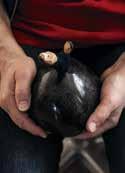

12 THE ARCTIC LIFESTYLE MAGAZINE
PEOPLE
Everything finds its place in Britta Marakatt-Labba’s embroidery and art. From nature to myth. And she, herself, is now exploring new fields for her art.
her father went out to see to his reindeer and was hit by a taxi travelling from Finland. He died. Britta was five years old. She was sent to the nomad school in Kiruna, which she describes as misery, in a time and town full of racism and contempt towards the Sámi. Then she chose the college for adult education in Sunderbyn before continuing to the School of Design and Crafts in Gothenburg. A time she describes as yet another extreme. As a Sámi she was considered exotic. The two extremes have left their mark: the feeling of being there, but never really being part of the context.
The potatoes on the cooker are done and Britta peels them as we chat. She is careful with details. To make proper mashed potatoes you should not peel the potatoes before you boil them, “no, then the mash will be watery and tasteless”, you peel them afterwards. The minerals and flavours are left, and it gets thicker.
“I like details and organisation. In that sense my studio probably doesn’t look like that of other artists”, she says and chuckles.

We enter the studio, a fairly simple room, bright and tidy, and not very big.
“Did you make Historjá here?”
“Yes, exactly, over there at the table with the pincushions. I had it on a roll, and embroidered one length at the time.”
“But 24 metres?”
“I know, it wasn’t ideal. First, I made a 16-metre section, and then I made another one that was eight metres long. I should have made several sections of four metres each instead, that would have been easier.”
Everything is about images, images that exist inside Britta’s head, slowly travelling down the white fabric of her embroidery. She treasures her images. She worries they will disappear. But this is also a practical problem. To get orders
The slow work of embroidery also gives Britta time to reflect on the story she wants to tell, some stories take years.
13
PEOPLE

14 THE ARCTIC LIFESTYLE MAGAZINE PEOPLE
from larger institutions, those with money, she needed to be able to show sketches. But Britta was not able to turn her images into sketches, instead she cut and pasted various collages to show her ideas. Today it is easier, these days she also makes illustrations.
in the studio there are a set of stone sculptures sitting on wooden logs. I ask her who made them and she answers that it is her work.
“What?”
“Yes, I’ve started going to the stonepolishing workshop in Lannavaara. It’s damn hard work, but it’s fun.”
“But what does it feel like? I mean, going from needle and thread and soft fabrics to big noisy machines that polish stone. There is a difference, surely?”
“As a child I loved stones. Our reindeer herding land is in Norway. I used to play with stones there, stones that would become other things in my imagination.”
Before I know it, Britta sits down on a low stool in the studio and starts carving on a piece of wood.
“I have taken a course in wood carving as well. This is how we used to sit in my childhood, together around the fire, crafting and telling stories.”
As Britta Marakatt-Labba sits on her stool carving she conveys in a very steadfast manner that she is well aware of not being finished with her art at all. There are lots of things left to do. Many stories left to tell.
when she started with her art many laughed at her embroidery. They said: “But why don’t you paint instead? You’ll never finish that.” Now she has noticed how a lot of other artists have started with embroidery. But Britta herself has never been interested in anything else but being able to tell her images. “First, I could do it through my embroidery needle, now I can use other tools too.”
“It’s impressive that now that you have the opportunity to make money on your embroidery you choose other paths or expressions. Why?”
“I’m not interested in money. If that had been important to me, I’d never have started embroidering resistance art in the first place. Getting that breakthrough isn’t something that’s been a driving force either.”
“But sure, I could travel all the time if I wanted to, talking about myself and my art, you know, lectures, but it’s no fun. I want to tell stories.”
in 1981, once Britta had finished her education in Gothenburg, she joined the protest against the power plant expansion by the Alta River in Norway. She ended up in prison, as did many of the others who protested.
One of her first and strongest pieces of art is Garrját, or ‘The Crows’. The crow has always been a symbol of authority to the Sámi, a creature that grabs everything it can. In Garrját they fly across the protesters in Alta, but as
15
PEOPLE
“I’m not interested in money. If that had been important to me, I’d never have started embroidering resistance art in the first place.”
they land, they turn into police officers. The state authority that came there to carry out government work, grabbed the rapids and the land, and freedom, and stuffed electricity into its own pocket. Another piece of political work that has received a great deal of attention is Deattán, or ‘Nightmare’. Looking at one of its details you can see rats invading a Sámi hut. Many are struck by the terrible sight of rats eating the sleeping people around the fireplace, but an equally important symbolism is the number of rats that have invaded the most sacred spot in the hut – the kitchen area. No one was allowed to be there, just the housewife. You could only behave in a certain way there, using certain patterns of movement. The goddess Sáráhkká was the guardian of the home, but also the guardian of female reindeer during calving, and pregnant women in the home. Sáráhkká is perhaps the most beloved goddess in Sámi mythology, worshipped by both men and women. Having rats invade her world carries a strong symbolism in Deattán.
the entire life of the sámi is based on storytelling. The written word came late, and the oral story carries the culture.
As Britta and I talk today, I can hear how she talks in images. For example, when we speak about how it took 40 years of embroidery for her to get a breakthrough, she first says that she has never been keen to change her way of
working just because something else has been trendier. How other artists have been inclined to change their form of expression – she uses the word ‘turncoats’ – and then her imagery comes in:
“You know, they’re more like a spring fire jumping from one tuft of old grass to the next. What happens is that those old tufts flare up, the ground gets slightly burnt, but it doesn’t burn deep.”
“Sure, green grass will grow there quickly, but the animals don’t like it. It’s pretty to look at, but of little use.”
deattán is about another kind of violation, not the kind that takes place in public, visible to others. The Sámi live by and from nature and are in a way bound to the soul of nature. The rats invading Sáráhkká’s kitchen area is also a violation of Sámi mythology, as it affects the land. A tree is more than just a tree, a fish is not just a fish, and a cloudberry is more than just a berry.
“When the Sámi pick berries or catch fish, they say a kind of prayer: ‘Do not let my hands ruin the land that I have borrowed’.”
“Life is constant interaction between event and mythology.”
Sámi culture is colourful and ornate in so many ways. Traditional costumes and jewellery are full of expression and provide a parade of colour. But Britta Marakatt-Labba’s art has always been low-key and almost graphic. Why?
“Why? Well, because that’s how I see my images.”
16 THE ARCTIC LIFESTYLE MAGAZINE
PEOPLE
For generations, life in Sápmi was based on oral storytelling. In her studio, Britta Marakatt-Labba gives color and life to the stories and myths of the past.

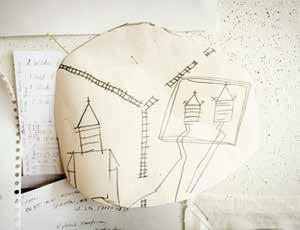


17
Photos:
Carl-Johan Utsi
PEOPLE
OUR TILTED WORLD
If you visit Swedish Lapland during the summer, you’ll notice that it never gets dark. You have entered the world of the midnight sun, an extraordinary experience that might affect your sleep quality. In other times of the year, you probably don’t want to sleep either since you want to enjoy another light show of sorts.

18 THE ARCTIC LIFESTYLE MAGAZINE
TEXT & PHOTO : DAVID BJÖRKÉN
NATURE
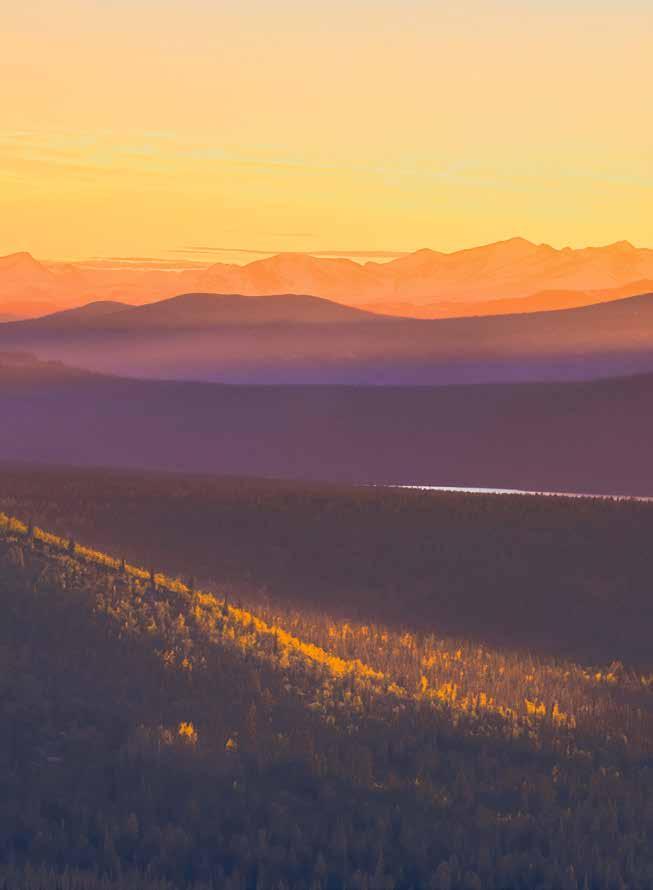
19 NATURE
the arctic circle marks the southernmost point at which the centre of the sun is visible during the June solstice. The summer solstice is the time of the year when the sun is always visible –the sun just never sets. In the northern hemisphere, the summer solstice falls around June 21 and the farther north you are, the longer is the polar day.
In reality, the Arctic Circle is not an absolute border – you can see the midnight sun as far as 90 kilometres south of the Arctic Circle. There is also a
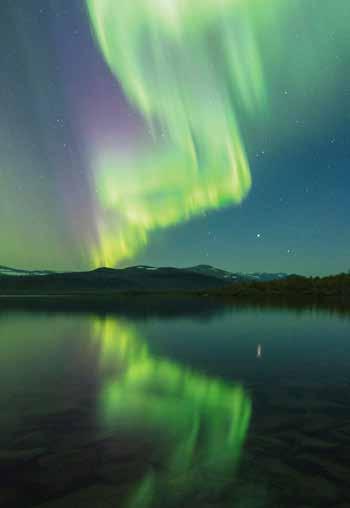
slight variation from each year and varies depending on the topography.
in the sámi language, the sun is called Beaivi, but Beaivi is also the goddess of the sun and has a central place in Sámi mythology. Every year – back in the days – a white reindeer was sacrificed as an assurance that the sun would return after the long and dark winter. At the summer solstice, they tied together rings of leaves and flowers which was put up to honour the goddess. You could find this custom today in the traditional Swedish midsummer celebration – a tradition that might have pagan roots. But there is no known historical link between the Sámi custom and the old Nordic one.
It is also said that when the sun returned, they prayed for the feebleminded because they thought that mental illness was induced by the long and dark winter. As we should learn further down, we are indeed affected by the light in different ways, a custom that has scientific support. As a first-time visitor it can be a challenge to cope with. That the Sámi adored the sky was nothing different from the rest of the world. The stars have always captured our interest. Wherever they could be seen.
but, as you know, our amazing night sky has more to offer than midnight sun and northern lights. Yes, during the dark part of the year, we often get to enjoy the dance of aurora borealis. A magic show created by charged particles from the sun accelerated by the Earth’s magnetic field towards the poles where they collide with particles in the upper atmosphere: the origin of the northern lights. But experiencing the starry sky on a clear night without northern light, or moonlight, is almost as fascinating.
20 THE ARCTIC LIFESTYLE MAGAZINE
Aurora borealis – the northern lights – is visible from August until April.
NATURE
Photo: Cody Duncan

21
NATURE
The North America Nebula (NGC 7000) in the constellation Cygnus photographed from a location close to Jokkmokk. The shape of the nebula resembles that of the continent of North America, complete with a prominent Gulf of Mexico.
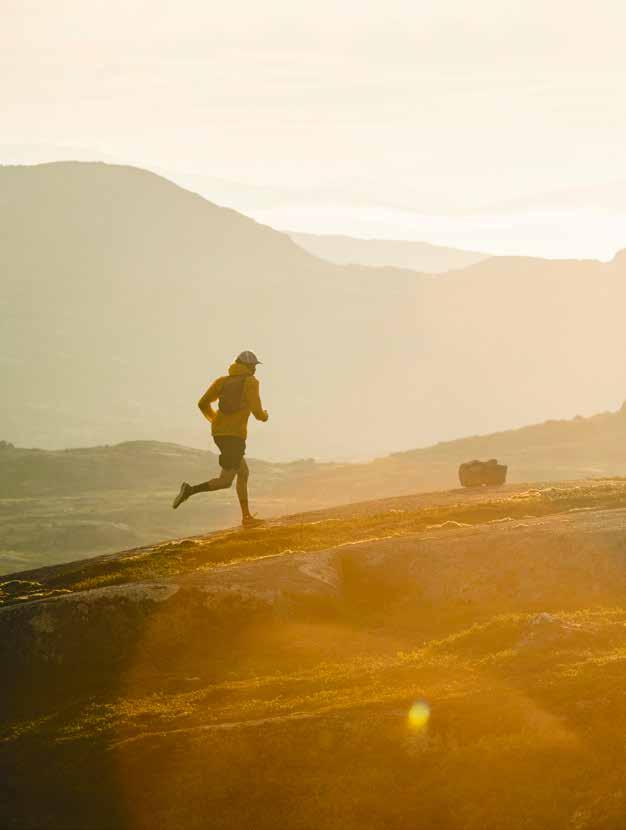
22 THE ARCTIC LIFESTYLE MAGAZINE
NATURE
Photo: Mattias Fredriksson
Standing in the dark, looking up and seeing the multitude of stars in the Milky Way stretching out across the sky. Discovering the tiny, blurred spot in the constellation Andromeda, the most distant object we can see with our naked eye – our spiral galaxy neighbour M31, the Andromeda Galaxy, located some 2.2 million light-years away. Marvelling at the tiny group of twinkling stars that make up the small open-star cluster The Pleiades. Or watching the mighty constellation Orion extend across the starry sky in wintertime.
It’s an almost overwhelming feeling as I stand there in the dark. Not only does it remind me of our own smallness, in relation to our universe. It also gives a sense of contact with our own history – our human history. I stand there in awe looking at the same stars as our ancestors did. There is something profound and existential about this, and you get a sense of why the starry sky with its different phenomena has been so important to mythologies and the creation of stories for all time and all folks.
in general, we are not aware of the precision in the timing and coordination of numerous events in our bodies, unless it’s disrupted (most of us know the feeling of being jet-lagged). However, processes as fundamental as the timing of sleep and its coordination with feelings of hunger are a manifestation of numerous physiological and biochemical events that change systematically and predictably throughout the day.
Light is essential for a lot of nonvisual functions: synchronisation of our biological clock, stimulation of human alertness and cognition, memory, reproduction, energy balance, to name a few.
The mechanisms underlying the positive effects of light for mammals remain
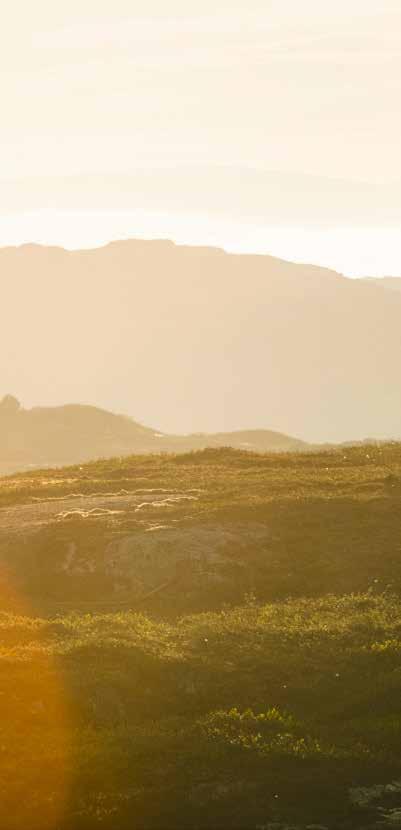
23
NATURE
The midnight sun
What is the midnight sun
the midnight sun is a natural phenomenon that occurs in the summer months north of the arctic circle. it means that the sun remains visible at nighttime. locations south of the arctic circle experience midnight twilight, which means daytime activities are still possible without artificial light during nighttime. this is also known as midnight light or white nights.

What to bring
sunglasses may be handy when driving a car at night since you may be blinded by the sun being low in the sky.
Summer solstice
also means that the sun reaches its highest position in the sky during day. this occurs approximately on:
JUNE
21
mostly unknown. However, researchers have discovered a new type of light-sensitive cells in the retina of our eyes, called melanopsin. This photoreceptor is thought to relay information about light to non-visual centres in the brain through direct pathways.
hypothalamus is part of the limbic system, a system of the brain that is involved in the regulation of a variety of fundamental and essential functions of the body. The hypothalamus as such is a small almond-sized structure involved in functions such as thermoregulation, blood pressure, heart rate, arousal, energy balance, memory, and sleep.
The suprachiasmatic nuclei (SCN) is a small region in the hypothalamus, responsible for controlling circadian rhythms, which is an oscillating biological process that helps us establish a sleep pattern – our master clock.
The retina of our eye consists of rods and cones responsible for vision, but the retina also contains photoreceptor cells that project directly to the SCN in the hypothalamus, thus providing information about light and dark.
Through different pathways, the SCN controls the release of various hormones such as somatostatin, oxytocin, and melatonin from structures as the hypophysis and the pineal gland as a response to the incoming information from the eye as well as the interpretation and expression of specific clock genes in the SCN.
When the sun goes down, melatonin (and other hormones) is released as a signal that it is time to head to bed. But what if the sun doesn’t go down?
researchers at the University of Tromsö has found that some Arctic animals such as the reindeer show circadian rhythms only in the parts of the
24 THE ARCTIC LIFESTYLE MAGAZINE NATURE
1. from mid march the north end of the axial of the earth tilts increasingly towards the sun, reaching a maximum 23° tilt at solstice.
2. at this angle everything above the arctic circle at 66°n is exposed to the sun 24 hours a day.
3. when the axial of the earth tilts the other direction during winter everything above the polar circle is hidden from the sun.
arctic circle
23° the sun
Ideal
conditions
to give you the best oppurtunity to enjoy the midnight sun, check the weather forecast for a clear night and go to an open area.
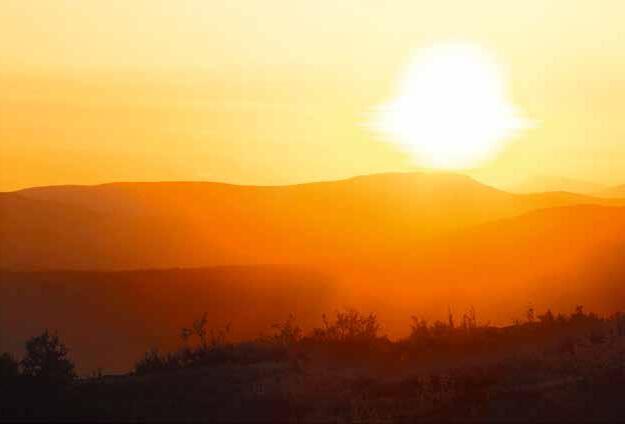
on the north pole, the sun only rises once a year at the end of march and stays up until sunset at the end of september. this phenomenon is also referred to as polar day.
year that have variations in brightness between night and day. The researchers could see seasonal changes in foraging, metabolic activity, and power of diel and circadian rhythmicity; effects that could be viewed as adaptations to the extreme living conditions in the high Arctic. Reindeer even change the function of the eye between summer and winter. In summer the reflective surface behind the retina gets golden, something that mammals active at night usually have. In winter, the same part of the eye will get deep blue, to better deal with the lack of light. With these winter eyes reindeer are able to see into the ultraviolet spectrum. However, this is not the case for humans. So even for the inhabitants of Swedish Lapland and the other Arctic regions, sleep deprivation could be a problem. How could we cope with the midnight sun and what can we do to maximise our beauty rest?
it’s quite easy actually. We need to reduce the light reaching our eyes. That could be done wearing sunglasses during the most intense daylight. And in the night use thick curtains in your bedroom – it should be as dark as possible so the photoreceptors in your eyes signals to the suprachiasmatic nuclei, which in turn tells the pineal gland to release melatonin, making us sleepy. Easy, right?
A good tip could be to bring a sleep mask, but to be honest – who travels to Swedish Lapland to sleep through those fabulous lukewarm and bright nights? The best recommendation is for you to stay up all through the night. Just get out and experience all the wonders Swedish Lapland has to offer. This place is for adventures and thrill. But to sit down and relax, grasp the beams from the sun that never sets behind the horizon, is nothing but pure magic.
25 NATURE 23 –24/5 – 18 –19/7 27–28/5 – 14 –15/7 31/5 –1/6 – 10 –11/7 4–5/6 – 6–7/7 8–9/6 – 2–3/7 12–13/6 – 28 –29/6
SORSEL EA RV IDSJAU R
ARJEP LO G SKELLEFTEÅ
PITEÅ JOKKMOKK ARCTIC CIRCLE
LU LEÅ PA JA LA GÄ LLI VA RE
KALI X ÖV ERTO RNEÅ ÖV ERKALIX KIRUNA HA PA R ANDA BODEN ÄLVS
BY N
Where and when to see the midnight sun
the map shows which dates the phenomenon is visible. the further up north you go, the longer the period of the midnights sun gets.
Quirky fact
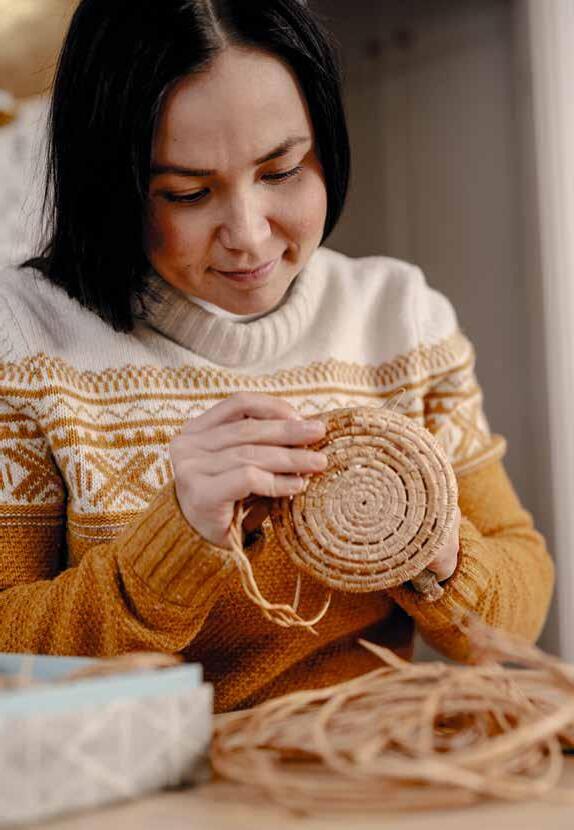
26 THE ARCTIC LIFESTYLE MAGAZINE PEOPLE
All about ÁRBEDIEHTU
Simply put, painter and craft artist Leila Nutti is a jack of all trades. But what she does is perhaps more aptly described by the Sámi word árbediehtu.
when leila turned 18 her father registered a company in her name. That’s just how things are in the Nutti family.
“While I was I growing up I noticed that people were always working. For me, work is a natural, everyday part of life. Just doing. When you sit around the fire and tell stories or, nowadays, when you’re watching Netflix, your hands are always busy. I think there is some kind of mindfulness in allowing your hands to be occupied with art craftwork.”
Leila always saw her mother and grandmother busy with duodji, Sámi craftwork. They were making pewterembroidered leather bracelets and handbags that would be sold at markets. And she had seen her father fixing something that was broken or crafting something new, or deliberating with her mother about what must be done with the reindeer. Always the reindeer. Although so much else can be said about the Sámi culture and way of life, reindeer are never far from discussion.
When we decided to meet for this interview I suggested a date. Leila replied that it would probably work
leila nutti: reindeer herder, artist, author and more

With her roots in the Sámi culture, Leila Nutti’s passion for root weaving and colorful painting creates traditional artifacts as well as cool prints.
for her, provided it wasn’t during the season when the reindeer must be separated from the herd.
not only a reindeer owner and painter, she is also a craft artist and has written a book about reindeer herding with dogs. This, in turn, has attracted tourists, who come to learn about the latter. In addition, Leila co-manages a project to promote Arctic design throughout the world. When we meet at the Ájtte Museum in Jokkmokk, it is snowing heavily and she has just returned from New York. As part of the project, together with several other designers from Norrbotten and Västerbotten, she has attended a seminar and an exhibition of the group’s work.
“It’s an incredibly exciting project to work with. With us in New York were Care of Gerd, a producer of skincare products, Hikki, who makes supercool outdoor bathtubs, and the Sámi glass artist Monica L. Edmondson. There is such an incredible range in a project like this, as well as in our designs. And it’s not just Sámi things, but more about what the northernmost part of Sweden
27
PEOPLE
TEXT: HÅKAN STENLUND | PHOTO: CARL-JOHAN UTSI
Duodji are handicraft items made by Sámi artisans. The items have their own artistic expression and background in Sámi traditions and way of life. Duodji often has a practical function. The materials used are normally what can be found in nature or provided by the reindeer. Duodji is an important part of Sámi culture.
has to offer. The intention is that about 50 companies from the north will have the chance to attend these shows throughout the world. First up was a visit to Copenhagen, and then New York. The next one will be in Paris, followed by Toronto, and then Tokyo.”
the difference between Tokyo and Eanonjálmme, where Leila’s reindeer graze during the summer in Sweden’s largest Sámi village, Sirges, couldn’t be more striking.
“I couldn’t agree more. Tokyo is an entirely different world. And new technology has made the world a completely different place.”
Leila Nutti, born in 1991, is somehow at home in a time that no longer exists. When she concluded here studies at the Sámi college, Samij Åhpadusguovdásj, in Jokkmokk, she made an item in woven root, sewed a coat from the pelt of a reindeer calf and fashioned a gietka, or crib. At the same time she has all the social media she needs to be present in the digital marketplace.
“That’s so strange. If I could choose, I wouldn’t live in the digital world at
all. But that’s impossible, since I run a company, and that’s just how things are. The implication is that I sometimes know more about what’s happening in American politics than I do about what is really important to me. Will it be good conditions and grazing during winter for my reindeer, or not?”
Everyone in her family works with reindeer. Her parents are still active. Her older sister has scaled down a bit since starting a family, so her younger brother is now the one who is most often out freezing on a snowmobile. That’s family life among the Sámi; everyone helps out when and however they can.
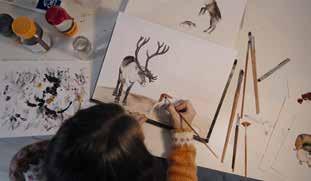
“During certain periods reindeer are the only concern. When it’s time to work with the herd, you can’t simply say, ‘Sorry, I have a meeting.’ It would be irresponsible to book a meeting at the wrong time.”
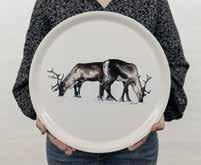
leila sees herself as more of a painter than a craft artist. The artistic streak is part of her family heritage. Lars J:son Nutti was her father’s uncle. As we wander through Ájtte we pause to admire a gigantic work by the famous artist.

28 THE ARCTIC LIFESTYLE MAGAZINE
Leila’s work is inspired by the Sámi lifestyle and the environment that surrounds her.
Photos: Håkan Stenlund
DUODJI
PEOPLE
Jokkmokk is the home turf for Leila, but her work with the project Arctic Design of Sweden aims to bring Arctic designers out to the broader market. arcticdesignofsweden.com
At first it looks rather abstract. And, certainly, it is abstract and very colourful, but amid the profusion of colours appear various more or less detailed images. I stand eye-to-eye with a beast that seems to be hiding in the painting.
“It might be some kind of gufihttarat, says Leila, smiling. The Sámi culture has always been very didactic. Parents frighten their children by saying that, if they poke a stick in the fire, their reindeer calves will go blind. Of course, no one wants to blind the calves; we love our animals, but it was really just a way to prevent sparks from flying out and starting a fire in the hut or tent. I sort of miss that these days. Now, we just give the kids a tablet to play with instead, so they don’t play with fire or wander off into the woods.”
Her paintings are inspired by the Sámi lifestyle and the environment that surrounds her. She wishes to represent the natural environment and express the feeling of contentment she experiences when she is in it.
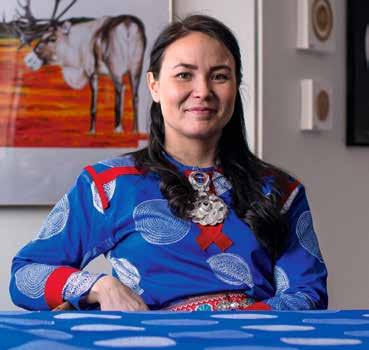
one sámi word that often crops up is árbediehtu – the transfer of traditional
knowledge that the Sámi people carry with them, without it ever actually being taught. It is a sort of collective knowledge that is born within the individual. In Leila’s case it is rather obvious; since she grew up watching people who were always at work and doing crafts, she has inherited it naturally. At the same time, she has a strong will to preserve and pass on certain things that are vanishing, for example, root weaving.
“I had fantastic teachers when I attended the Sámi college, ‘Samernas’, in Jokkmokk. The school has always had great teachers, the kind who really know how to pass on the tradition.”
“There, root weaving was important for me; not because I wanted to make money doing it, but more because it is an important part of Sámi tradition.”
We pause in the new section of Ájtte museum that features duodji to look at a woven root artefact by Ellen Kitok. At first glance it looks like a sun hat and could well function as one, but it is actually a large sort of dish. A masterpiece, it is a wondrous work of art in which birch root has been tightly woven into a magical basket dish. She has rendered
29
Photo: Tor L. Tuorda
Illustration: Leila Nutti
PEOPLE
it with astonishing skill, especially when you know how difficult the root weaving technique is and how many hours of painstaking work it takes.
during our discussion Leila frequently mentions the school, which is often simply referred to as Samernas. Does it have great meaning?
“Well, yes, you could certainly say that. Going to Samernas is a bit like compulsory military service; it isn’t a question of whether you do it or not, it’s a matter of when. In our community there is a before Samernas and an after Samernas.”
Ellen Kitok, mentioned above, has been a teacher at Samernas. A grant honouring Ellen’s mother, Asa Kitok, who taught root weaving, has been awarded annually at the Jokkmokk winter market since 2005. The first to win the grant was wood and antler craftsman Jon Tomas Utsi, who taught at Samernas for many years. Root weaver Fia Kaddik, also a former teacher at Samernas, has also won the grant. The transfer of traditional knowledge and skills is not something to be taken lightly. And it has to be done well.
leila hopes to be able to learn more about root weaving. As a student at Samernas, she discovered that the techniques and forms of expression used by Sámi craft artists in the far north differed from those used by Southern Sámi craftspeople. She wants to know why. But when will she find the time? When it comes to work, she already has at least five irons in the fire.
“I work in a very structured way. I let the seasons dictate what I’m going to do.”
Now, during November and December, all of her time must be devoted to the reindeer. The animals must be
separated from the large communal herd and identified according to their owners, and it is vital that they reach good winter grazing lands. After Christmas and New Year’s she returns to her studio and produces the art she will exhibit at the winter market. Then comes a period during which she welcomes tourists who come to Jokkmokk to work with their herder dogs. In May, during the calving season, she pulls the plug, heads for the high country and lives the simple nomadic life. This is a time when she tries to scale down.
“It can be difficult to reach me in May. That’s when I charge my batteries, when I’m up in the mountains with the reindeer during calving. It’s probably our most wonderful time of the year. It gives me the renewed energy I need for a trip to Paris or Tokyo, or even to just pick up my phone.”
but what do the mountains mean to her, really? Is it the place or the reindeer?
“I can’t really say if it’s the one or the other. The two go hand in hand. Holistic may sound pretentious, but that’s exactly what it is. It’s all one and the same thing and we are part of the ecosystem. For me, personally, the mountains are my happy place. I’d rather go there any day of the week than travel abroad. Up there, you get back to basics, the modern world is placed on hold and you only concern yourself with simple things. Will we catch any fish for lunch? Do we have enough firewood at our camps? There is an overwhelming sense of gratitude for being part of nature, while there is a realisation that it is all so fragile. During the calving season, when the new cycle of life is born, everything is so delicate and vulnerable. Nature can wipe everything out with a snowstorm. The modern society can obliterate it all
30 THE ARCTIC LIFESTYLE MAGAZINE
PEOPLE

31
PEOPLE
“It can be difficult to reach me in May. That’s when I charge my batteries, when I’m up in the mountains with the reindeer during calving.”
by opening a new mine. All of this beauty is also threatened. It can be so liberating when the simple, day-to-day tasks become most important. Hauling firewood is quite simply a form of mindfulness.”
naturally, the reindeer is a central feature in Leila’s art. Her watercolours are not full of abstract explosions of colour; instead, they are more minimalistic and free of embellishment. Otherwise, the Sámi visual expression is often characterized by bold colours. This becomes apparent when you see Ájtte’s new exhibition. Hundreds of incredibly beautiful and colourful woven bootlaces are displayed in a cabinet. How is it that indigenous peoples who have lived so close to the earthy, subdued tones of nature can be so taken by these bold colours?
“I really don’t know. But I have noticed that people from other indigenous cultures throughout the world also like bold, bright colours. I also know that the Sámi were very good at bartering. They were clever hunters who could trade pelts

and hides for silver and beautiful fabrics. Then, back in the day, you received the equivalent of a lumberjack’s weekly wage in exchange for a fox fur or wolverine pelt. The hunter held hard currency in his hand.”
Leila tells us that, according to Sámi tradition, a piece of silver jewellery is placed in the crib of a newborn child. Nowadays, young parents hang a silver ring in the child’s baby carriage. Otherwise, the gufihttarat (the underworld people) will exchange the child for one of their own. You might take similar tales with a grain of salt, but here, in ‘normal’ society, many of us still have Luther on our backs. In the Sámi culture the birth of a child was not taken lightly. If you can afford to put a piece of silver jewellery in the crib, at least you can support your family.
When Leila Nutti turned 18 her father registered a company in her name. That’s just how things are in the Nutti family. Cultural heritage in a modern form – contemporary árbediehtu.
32 THE ARCTIC LIFESTYLE MAGAZINE
PEOPLE
DESIGNER’S DREAMS
One room looks like a bird’s nest while another resembles a UFO. There is also the hotel with a train depot ruin straight through the kitchen. And the city hotel that cleans the air to the same extent as an entire forest. We travel between excellent accommodations in Swedish Lapland.

33 DESIGN
TEXT & PHOTO: HÅKAN STENLUND
mikael vinka sits at the rough-hewn dining table in the dining room at Geunja, the Sámi eco-lodge he built by hand 20 years ago. He remembers the effort.
“To sum it up, it was damn hard work. That’s probably all it was.”
In those days, eco-things were not in fashion, like they are now. The mountain world where Geunja is located belongs to Sorsele municipality. It became an eco-municipality already back in 1989, one of the first two in Sweden, but even so, saying that it was something of a movement back then would be an exaggeration. Mikael and Anki Vinka’s idea, however, was to build Geunja and make it something extra special. The location was an old residence at Tjulån, in the Ammarnäs mountains. There was a spring on the site: a prerequisite for good water in summer as well as in winter.
Mainly it gave you a feeling of being welcomed on the spot. That’s the most important thing when you look for somewhere to live. That you feel like you want to be there.
Mikael hand-hewed the logs, insulated them with moss and used peat and birch bark as roofing. Everything was done the same way it was when the first nomadic Sámi became settlers, part of the Sámi tradition that is sometimes forgotten.
“You know, even the nails are old handforged nails. If carrying the stone for the fireplace was a struggle, that was probably nothing compared to the frustration of trying to hammer in hand-forged nails. You quickly learn to hit them straight”, Mikael says.
Today, Geunja welcomes twelve guests about twelve times per year. They do everything to make sure the place does not get worn out, and for us to feel welcome.
in riksgränsen, a bit further north in the mountain world, there is Niehku Mountain Villa. A hotel dream as far north and as far away from the rest of Sweden as you can g et, more or less. At a Unesco gala in Paris,
Niehku won the prestigious Prix Versailles for the best hotel interior in the world. Stylt Trampoli, responsible for the interior design and Krook & Tjäder for the exterior design, have succeeded in capturing the uniqueness of the history of Riksgränsen – the Ore Railway – and it breathes new life into the building. The stone wall of the old train depot runs straight through the hotel building and in the restaurant the grease pit for the steam trains of the time has become the perfect wine cellar. Niehku, the Northern Sámi word for dream, is founded by two friends: Strumpan and Jossi, or Patrik Strömsten and Johan Lindblom, names hardly anyone uses. Both of them came to Riksgränsen in the 1990s. Skiing youths with a greater passion for snow than school. The mountain and the distinguished old Riksgränsen Hotel were a haven. They hardly knew back then that it would also become a landmark in their lives. Jossi trained as a mountain guide and Strumpan became one of Sweden’s foremost sommeliers – the perfect combination to run a hotel filled with style-conscious skiers and travellers from all over the world.
design and/or boutique hotels, let us call them lifestyle hotels, is nothing new. They started to emerge already in the 1980s and perhaps Icehotel in Jukkasjärvi could be called the first in Swedish Lapland. In the 2019/2020 season, Icehotel celebrated its 30th anniversary and as always, design and the work of artists have been a priority. If mentioning five key points for a hotel to be referred to as a lifestyle hotel, the first thing to remember is your Shakespeare. “All the world’s a stage, and all the men and women merely players”. Icehotel has been offering today’s bucket-list travellers a stage for three decades. That desire to blur the boundaries between outside and inside is something Icehotel always succeeds in.
More than anyone else, it was the Americans Ian Schrager and Steve Rubell who set the criteria for what a lifestyle hotel is. They are the founders of the legendary club Studio
34 THE ARCTIC LIFESTYLE MAGAZINE
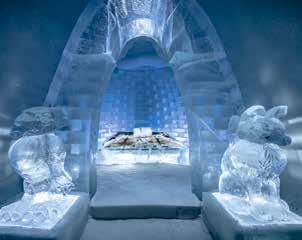


35 DESIGN
“All the world’s a stage, and all the men and women merely players.”
WILLIAM SHAKESPEARE
Photo: Ted Logart
Photo: Asaf Kliger / Icehotel
Photo: Philipp Herfort
Geunja, the Sámi eco-lodge
Icehotel
Niehku Mountain Villa
54 in New York, and the creators of the hotel
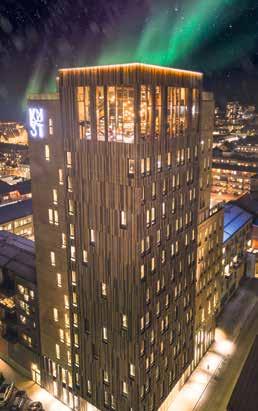

The Morgans. According to them, a lifestyle hotel should indeed be a theatre stage with the lobby as its centre. The hotel should reflect the lifestyle of its guests and blur the boundaries between outside and inside. Preferably, the hotel itself should be the main reason why someone would visit the location at all. The hotel should be a destination in itself.
in the lobby of kust hotel and spa in Piteå there is an old, dry pine tree. The combined restaurant and rooftop bar at the hotel is called Tage. Both things are attributable to Tage Skoog, the man behind the Skoog Group who owns the hotel. Tage found the tree when the lobby was almost finished. He called his daughter Christina and said he had “found a twig” and that he thought it would look good in the lobby. Since it was her dad calling her, the tree ended up in the lobby, of course. They actually had to rebuild the entire entrance of the hotel to accommodate the tree. Remember what you read earlier: in a boutique hotel, the

36 THE ARCTIC LIFESTYLE MAGAZINE
Photo: Jens Wennerberg
Photo: Viggo Lundberg
KUST Hotel & Spa
Arctic Bath
DESIGN
Bertil Harström in front of UFO, one of the tree houses he designed for Treehotel.
lobby is the centre. In the lobby bar, that could also be called the gin bar, I have a gin and tonic this afternoon while I wait for Christina Skoog, who is going to answer some of the questions I have.
“Tell me about the façade, how is it unique and how does it work?”
“It is a concrete façade made with a mixture of titanium oxide, which means that the entire façade absorbs carbon dioxide and works as a lung”, Christina says, and continues:
“But besides getting rid of carbon dioxide – and those results are completely measurable –the titanium oxide helps keep the façade clean.”
Because of this façade, Hotel KUST in Piteå won the Environment Prize of the year, awarded by the construction industry. And because of its interior, the hotel KUST, one of the main reasons for visiting Piteå, was named Northern Europe’s best new hotel and Northern Europe’s best boutique hotel by the World Luxury Hotel Awards.
bertil harström, fly fisherman and architect, has already turned 70. This afternoon he takes a stroll outside Arctic Bath, a new cold bath house on the Lule River outside Harads. The concept was born almost ten years ago, at the after-party of the inauguration of the newly opened Treehotel. Someone patted Bertil on his shoulder and said: “Now you have to design a sauna raft for the river, so people staying at the hotel have something to do”.
“So, this is basically an after-party that went overboard”, he says and laughs.
“At the time I didn’t really think a sauna raft would be my next project and I didn’t do anything about it. Ten years passed, but that’s when the idea about the river got firmly lodged in my head.”
The ‘sauna raft’ became a 700 square-metre cold bath house and hotel named Arctic Bath, where shape and design are inspired by old-fashioned log jams on the river. The resulting creation is Sweden’s perhaps coolest hotel project.
by now, most of you are familiar with the story about Treehotel. About a group of architects on a fishing trip with Kent Lindvall, and how they started talking about the film ‘The Tree Lover’ by Jonas Selberg Augustsén around the campfire one evening. The film had just been shown on Swedish television and brought to life a childhood dream of building tree houses. The project around Treehotel brings together some of the most recognised architects and designers in Sweden and Scandinavia. Tomas Sandell, Tham&Videgård, Cyrén&Cyrén, Sami Rintala, Snøhetta and Bertil Harström – they have all built a tree house each, now rented out as hotel rooms. Bertil is the only one who has two tree houses at Treehotel. One looks like the most common house in a forest: a bird’s nest. The other one is its opposite, the most unexpected thing you could come across in a forest: a UFO. Bertil has also designed the public facilities at Treehotel, such as sauna, relax and spa. He has an unfaltering love of wood.
“Yes, damn it. I don’t think there’s anything sadder than the image of trucks driving timber down to the coast.”
“Beautiful trees exported at the going dollar exchange rate. It’s so unimaginative.”
for more than 30 years Bertil Harström has been fighting for people’s right to build wooden houses. His love of tree houses and log jams sits deep inside his soul. He is an architect and designer, but deep down he is more of an idealist and tree hugger. These projects are not just an architect’s vision and dreams,
37 DESIGN
“Arctic Bath is basically an after -party that went overboard.”
they are based on a belief that in Sweden we actually miss something when we do not allow ourselves to build more using wood.
“Wood is a brilliant building material. It absorbs moisture, binds carbon dioxide, transports heat, but still every Swede has to enclose his house in plastic to get building permits or a mortgage. It’s sick.”
These days Bertil sits at home in his old log house in Sundsvall, working. He used to run Inredningsgruppen, the largest agency of interior designers in the north of Sweden. But it got too much and he got worn out. He had to start over and do things differently. The house outside Sundsvall became a refuge.
“You know, internet, that was the rescue. I’m as connected outside Sundsvall as in New York. It really is possible to live and work in the countryside. Perhaps that’s why I am running these projects. To put the countryside in focus.”
Bertil is the designer of Arctic Bath and the idea of a cold bath house in the shape of a log jam was born a long time ago. Together with Johan Kauppi from Tornedalen he was able to create a new design hotel in Harads that has become a world attraction.
there are many design favourites in Swedish Lapland, and one of them is actually located in Tornedalen. Arthotel in Risudden is a kind of Swedish Sextantio, albergo diffuso. You know the story of Daniele Kihlgren, of Swedish descent, who came to an abandoned mountain village in Italian Abruzzo and decided to rebuild the entire mountain village Santo Stefano di Sessanio into a designer hotel. Gunhild Stensmyr came to Risudden in Tornedalen on a summer’s day. She was born in a neighbouring village, but like so many others she and the rest of Sweden packed up and moved to the city in the 1960s. Gunhild worked at various museums and art galleries before eventually working her way down to Skåne, where she got homesick and went back up to Tornedalen. The Tolonen house in Risudden was empty. She bought it, then she bought the Wennberg house, and then three more houses. She has now renovated them all, with first-class design, and packaged them as a hotel experience that is both a visit to someone’s home and exclusive, spoiled luxury.
“I’m not sure if luxury is the word for it, anyway this isn’t that kind of hotel. But I suppose it’s a kind of luxury to stay in a place where the hotel owner knows everyone, from the artists whose work is featured on the walls to the fisherman who provides you with Kalix löjrom”, says Gunhild.
“The advantage of Arthotel is the simple luxury of being completely surrounded by art and design, and at the same time bringing all of Tornedalen’s history and beauty across the threshold of the house.”
“The experience shouldn’t end just because you enter the house, it should be reinforced. That’s why art exists.”
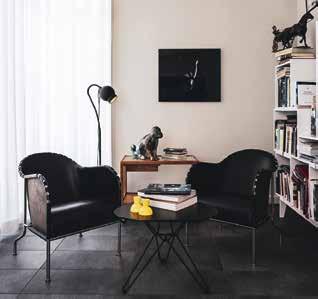
38 THE ARCTIC LIFESTYLE MAGAZINE
more: samiecolodge.com niehku.com icehotel.com hotellkust.com arcticbath.se treehotel.se/en/ arthoteltornedalen.se
Read
DESIGN
Arthotel Tornedalen
CITY DWELLINGS
sara
A building called Sara is built in the middle of Skellefteå. It is one of the tallest wooden houses in the world – a role model for sustainable design and construction. It will host the town’s cultural life as well as an excellent hotel. Sara is named after author Sara Lidman. The Wood Hotel is run by Elite Hotels.
Architect: White Arkitekter
shopping
When Luleå’s shopping centre ‘Shopping’ was inaugurated on October 27, 1955, it was actually the world’s first modern mall: a meeting place in an Arctic context. It lacks distinct floor plans and the unconventional space creates an almost labyrinthine interior.

Architect: Ralph Erskine
kristallen
Due to Kiruna’s city transformation a brand new city hall has been built. The so-called ‘living room of Kiruna’ is named Kristallen (the Crystal) and houses the city council as well as the Regional Art Museum.

Architect: Henning Larsen

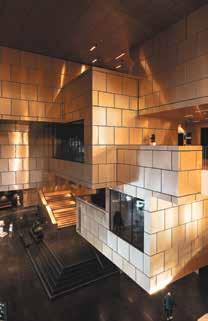
Architects
kunskapshuset (the Knowledge House) in Gällivare won the Swedish Design Awards. What happens when an entire town – Malmberget in this case – disappears? Where do all the memories and the knowledge go? Kunskapshuset is also a school, and it unites Sámi and industrial history in a magical building.
Architects: a collaboration between Liljewall Arkitekter and MAF Arkitekter.
39 DESIGN
Naturally, there are buildings with exciting design and architecture in Swedish Lapland that are not only related to the hospitality industry, but also part of the cityscape itself.
Sara Shopping
Kristallen Kunskapshuset
Photo: Håkan Stenlund
Photo: Anders Bobert
Illustration: White Arkitekter
Photo: Sune Sundahl/ArkDes
AND THE GOOD OLD ONES
1. Akerlund
Åkerlunds Hotel in Jokkmokk has been a classic hotel ever since the beginning of the 20th century. Renovated, modernised and renewed since then, of course. The Åkerlund family ran the hotel for several generations, but it has been run by others with roots in Jokkmokk for a few years now. The little hotel feels both cosy and traditional. Right next to the hotel is another classic Jokkmokk venue: the hundred-year-old cultural scene Bio Norden. Films and entertainment have been provided here since almost before the place existed. Bio Norden can be rented for conferences. hotelakerlund.se
2. Haparanda Stadshotell
The oldest city hotel in the destination Swedish Lapland is Haparanda Stadshotell, inaugurated back in December 1900. It was designed by architects Fritz Ullrich and Eduard Hallquisth, who also designed Haga Courthouse in Solna and the Eurydice district in the Old Town, both in Stockholm. At the turn of the century, Haparanda was where East met West, a meeting place between the Tsarist Empire and Europe. In April 1917 the Russian newspaper Novoje Vremja wrote that out of Haparanda’s 1,500 inhabitants, almost 250 people were estimated to be agents or spies. This is where the great powers held court; among crystal chandeliers, plush furniture and stucco work they thrived in the lounges at Haparanda Stadshotell. Nowadays the hotel has been meticulously and uncompromisingly renovated to once again provide an exciting setting for world travellers. haparandastadshotell.se
3. Pite havsbad
In 1944 Elof Söderberg from Jävre bought four hectares sandy beach on Piteholmen outside Piteå. There was a world war raging in the outside world. Land was cheap and a sandy beach was of little value. Elof was an electrician and entrepreneur, and he quickly set up some cabins for rent and opened a kiosk selling ice-cream. Piteå was the warmest place in Sweden for three years in a row in the early 1950s, and the public took to calling his place ‘the Northern Riviera’. People flocked and there was plenty of sunshine for Elof to make his hay. Today, Pite Havsbad is one of Swedish Lapland’s strongest brands: a full-scale seaside complex that has developed far beyond that icecream kiosk Elof Söderberg once set up. pitehavsbad.se
4. Luleå Stadshotell
In the beginning, this building was a combination of hotel and town hall. It was designed by architects Fredrik Olaus Lindström and Karl August Smith, and constructed in 1903. Smith went on to become Luleå’s city architect while Lindström became a city architect in Umeå, where he helped with the drawings after the great fire of 1888. Luleå Stadshotell now belongs to the Elite hotel chain and suffered a severe fire itself in 1959, which completely destroyed the hotel’s top floors. These days its decoration is slightly more modest. But there is still something wonderfully classic about its rooms, not least of all the stucco work in the festival hall, which is actually where breakfast is served. elite.se
5. ÅrreNjarka
The Mannberg family has operated a mountain farm in the village Årrenjarka since the beginning of the 19th century. The name means ‘Cape Squirrel’, indicating that the family earned some income through hunting – furs were hard currency – and agriculture was a way of getting some extra food. So perhaps it was not such a big step to start keeping a meticulously organised mountain farm – including their own, very tasty, potato variety – to house visitors on their way to Sarek and the Unesco World Heritage Site Laponia. The almond potatoes you can taste in the Njarka restaurant, where game and typical flavours from the area play the main role on the menu. This is a place filled with relics and stories from a time long before what we call modern, a story about a slowly changing cultural climate. arrenjarka.se
6. Saltoluokta
On the other side of lake Langas, at the outskirts of Sarek and Stora Sjöfallet, right in the middle of the King’s Trail, you will find the STF facility Saltoluokta. The timbered main building was erected as early as 1918, and has well-preserved fireplaces and plenty of charm. In winter you get here by following a prepared 3.5-km trail; in summer you take the boat, M/S Langas, across the lake (it follows the bus times). At Saltoluokta you have accommodation and activities conveniently located in the middle of the large, Unesco-designated World Heritage Site: Laponia. An area of outstanding universal value to humanity in terms of both culture and nature. svenskaturistforeningen.se
40 THE ARCTIC LIFESTYLE MAGAZINE DESIGN
They are the old -time favourites we often go to. Like friends we learned to know years ago, whos company we still enjoy and seek out. They are the good old ones.
1 3 5

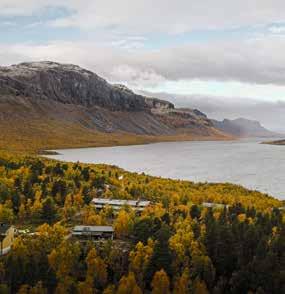
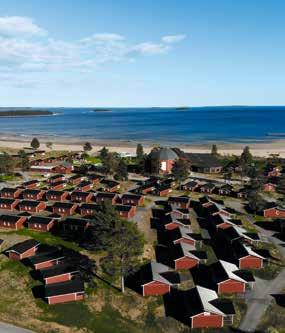

2 4 6


41 DESIGN
Photo: Håkan Stenlund
Photo: Håkan Stenlund
Photo: Håkan Stenlund
Photo: Linda Broström
Photo: Ted Logart
Photo: Ted Logart
THE MOVEABLE FEAST
Eating well is part of every journey. And on a road trip through Swedish Lapland you have every chance in the world to enjoy a moveable feast.
down at the shore of Alep Miekak stands chef Johan Eriksson, filleting a fish he has just caught. Planning to serve it as a starter for tomorrow’s dinner, Johann cures the fish quickly. Fresh fish straight from the lake, just the right amount of salt and sugar and it goes in the fridge. On the face of it, that doesn’t sound so remarkable. Even so, that’s about as simple and good as food can ever be. That’s pretty much what it was all about when the Nordic noir food trend went international. Fresh ingredients prepared and preserved according to ancient methods that were practised by the original inhabitants of the region. Smoked, salted, pickled or dried and, most of all, fresh and right on site. If the new Swedish cuisine wants to call itself progressive, Swedish Lapland can rightfully claim that it has been progressive for 6,000 years or more. We have never known anything else. A pot of water
is boiling over the fire, ready to poach another fish. Culinary art is second nature, even when Johan is up in the mountains.
restaurant oaxen, in Stockholm, with head chef Johan Eriksson from Piteå at the helm, was awarded its second Michelin star in 2015. The champagne corks hit the ceiling for an evening, and then it is time once again for low-and-slow cooking and simmering stock pots. Johan was head chef when Oaxen won its first star, and then its second. A colleague says jokingly that they will soon be on their way to the Holy Grail for fine dining establishments – a third Michelin star which had until then eluded Swedish eateries. Johan squirms a bit. He’s a little tired of that whole scene. He’s nearly going mad; he never has time to go fishing.
42 THE ARCTIC LIFESTYLE MAGAZINE TASTE
TEXT & PHOTO: HÅKAN STENLUND
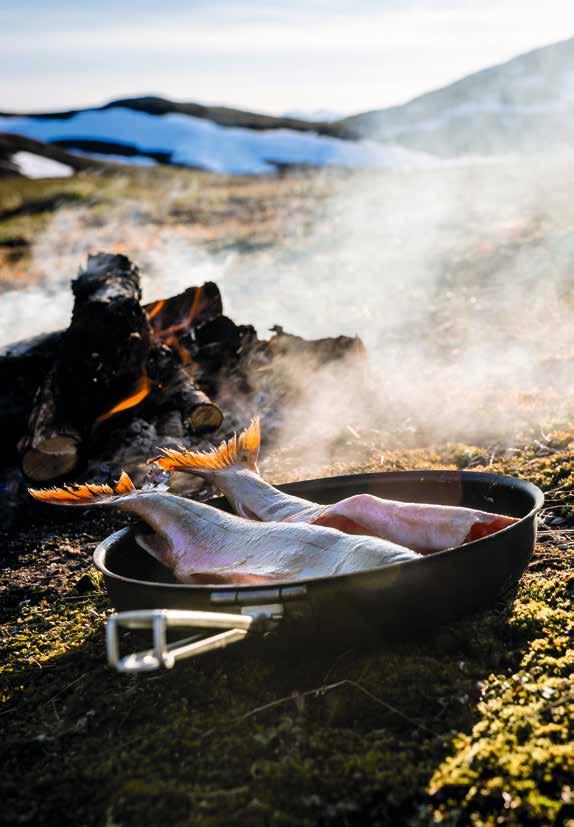
43 TASTE
Photo: Carl-Johan Utsi
we fast-forward the story a few years. Johan Eriksson grills a nicely aged entrecôte at the new bistro, Centrum Krog, which he has opened on the town square in Piteå. Between Oaxen and Centrum Krog he also did a stint at Hotell Kust, as well as baking some of northern Sweden’s best pizzas in the wood-fired oven at Kiosken pizza och vin. The Michelin star chef as a pizza baker. Laughing, he serves the rib eye to a regular guest and they chat for a while about this and that. It is just after eight on a Saturday night, this was the last order and the kitchen is about to close. Packed and ready, with a couple of fishing rods on top of his gear, Johan’s car is waiting outside. He’ll soon be on his way to the river.
The pizzeria is probably the final outpost of democracy. Without the local pizzeria, many communities in Sweden would have no restaurant at all. The taste of a Vesuvio pizza in Swedish Lapland barely differs from one in the south of Sweden. However, it goes without saying that Johan Eriksson’s pizzas are not of the run-of-the-mill reformed ham variety. The talent for good cooking never leaves someone who has led a two-starred Michelin kitchen. And the fact is, loving food and drink is getting easier, even in what is now known as Sweden’s Arctic destination, Swedish Lapland, over the past decade. Microbreweries and White Guide restaurants can now be found nearly everywhere.
but what does it take to be Sweden’s best sommelier? One way to do it is to quit high school, take a job in a ski-resort restaurant and ski your buns off while devouring as much wine knowledge as you can. Then, if you’re an autodidact, you might just have a chance
to be the first (and thus far only) wine aficionado to be twice winner of the Sommelier of the Year Award in Sweden. For Patrik Strömsten, “Strumpan” to most who know him, that was the perfect career path. And, along the way, a hotel came into the equation. Together with Johan “Jossi” Lindblom, Strumpan was part of the team behind the concept for Niehku Mountain Villa in Riksgränsen. From the kitchen, head chef Ragnar Martinsson serves up world-class food every day and the wine cellar is truly impressive. Although Strumpan has moved on, Riksgränsen, the place where his love of wine grew and flourished, will still be a part of his life. Naturally, Niehku remains; after all, what would you expect of a hotel that grew out of a railway ruin from another century? Under a glass floor in the middle of the restaurant, in what was once a grease-pit for steam locomotives, is a wine cellar. Sara Johansson is Niehku’s new sommelier. She has solid experience from having worked with Niklas Ekstedt, but also from her own project, Einer, in Oslo. In the wine cellar, she pauses in front of several cases of Phenomena, a Brunello di Montalcino Riserva by Giugi Sesti, but instead selects a Pinot Noir, from Domain de la Côte in Santa Rita Hills, in California.
vintner’s sasha moorman and Rajat Parr create magical wines. What started as a sort of garage project has become a world-class sensation. The organic philosophy has been replaced by all-out biodynamic wine growing. Nothing is added and nothing is taken away. What you get is the wines’ own character, from its own place, its unique terroir. And, in some way, this is
44 THE ARCTIC LIFESTYLE MAGAZINE TASTE
“But what does it take to be Sweden’s best sommelier? One way is to quit high school, take a job in a ski-resort and ski your buns off while devouring as much wine knowledge as you can.”





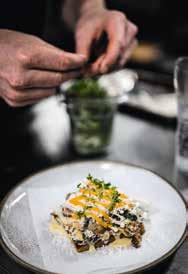

45 TASTE
Jossi Lindblom
Sara Johansson
Johan Eriksson
The Niehku dining room.
The kitchen team at Niehku getting ready for service.
Photo: Mattias Fredriksson
synonymous with how good food and wine should be produced. You start with something that interests you deeply and turn into something phenomenal, whether it has to do with a keen interest in wine, a sense of how one’s own beer should be brewed or how quickly a fish should be cured.

a couple of days after meeting Sara Johansson at Riksgränsen, I enjoy a ten-course tasting menu at Bryggargatan in Skellefteå. It is a gastronomic experience conjured up by Icelandic chefs Jon Oskar Arnason and Runar Larsen. Delightful. Always good, in fact. Excellent fish with a hint of liquorice usually appears on the menu, a passion they brought with them from the island in the Atlantic. Before the two Icelanders came to Skellefteå the town was well known for its hockey team, but scarcely for its food. On a dismal square, people might have been heard
arguing over who made the best kebab. Back then, the speciality wasn’t exactly sirloin of reindeer and deepfried gnocchi.
“No, the food culture didn’t bring me to Skellefteå. But Bryggargatan promised great possibility,” says Runar. “And the town is surrounded by nature. I pick wild mushrooms and berries and I hunt. I try to get out as often as I can. Perhaps it’s that, more than the actual restaurant, that makes me love this place,” adds Jon Oskar.
The evening’s ten-course menu is rounded off with a dessert complemented by a savoury piece of Svedjan cheese, a favourite from the village Stor-Kågeträsk. Here, we have to be honest. Over the past decade attitudes to food have changed, even here in the North. We are in the middle of Ostriket (The cheese country) and we have always had our fantastic Västerbotten cheese. That a couple like Johanna and Pär Hällström
46 THE ARCTIC LIFESTYLE MAGAZINE TASTE
“Someone has to depart from convention and lead the way. As always.”
Jon Oskar Arnason and Runar Larsen
Photo: Sven Burman
at Svedjan Ost would suddenly appear on the scene and be asked to make cheeses for the Nobel banquet was unexpected but very cool. Someone has to depart from convention and lead the way. As always.

in stor-kågeträsk the cows are still out to pasture. But their freedom to graze all summer long and well into the mild autumn will soon end when the days grow short and the northern winter comes.
“Quite simply, healthy animals produce the best food,” says Pär, looking out over the meadow down near the lake.
“We started making cheese because we wanted our cows to have a good life. We wanted to preserve a living landscape and keep animals that are healthy and content, but it was hard to make a living by just producing milk. So, one day we decided to try making cheese instead. But there’s not much money in making

cheese either. Timewise, it’s a long-term investment.”
Svedjans Gårdsost, a grainy hard cheese for which Svedjan has won numerous awards, must be aged for at least a year before it is “just right”. And when you are new to making cheese, how can you know what “just right” is? Pär now has a pretty good idea of what constitutes a good cheese. It has to be just how he likes it. When he and Johanna began their dairy transition, he had only one thought in mind – but he couldn’t be entirely sure until he had reached his goal.
today svedjan markets three cheeses, they run a summer café and they have relied on a few pigs to take care of by-products from cheese production during the summer. The pork is cured and served as lardo at restaurant Bryggargatan.

“The great thing is that we’re not alone in all of this. There is a growing interest among those who wish to

47 TASTE
Svedjan cheese served as a dessert at Bryggargatan.
Pär Hällström
Photo: Sven Burman
Photo: Ted Logart
Photo: Ted Logart
Anders Skum
eat well and locally, which means that Skellefteå can have restaurants like Bryggargatan and Luleå can have places like Restaurang CG and Hemmagastronomi. And there are more and better producers. When I was at Mathantverks-SM (Sweden’s national championship for artisan food) a few years ago, I stood quite close to my cousin, Anders Skum from Fjällvilt in Ammarnäs,” explains Pär, adding, “We both went home with awards for our culinary art.”
Swedish Lapland or Sweden’s Arctic region can scarcely be mentioned in a culinary context without a hats-off to the Sámi kitchen. Unlike the mass-produced, pre-packaged kind you find in a supermarket, Anders Skum’s renskav, thin-sliced reindeer meat, is hand cut with a knife.

“When we decided to sell renskav and suovas, using a machine to process it was out of the question. The meat must be cut in thin slices, just as we prepare it ourselves, at home in our kitchen. It should feel as if the meat has been thawed to just the right degree and then perfectly sliced with a sharp knife.”
In the Sámi language ‘perfectly thawed’ translates as surmmit, a word for when the sun melts the hard crust overlying the snow just enough to give the ideal
surface for skiing. The Sámi have 300 words for snow. But to describe perfectly smoked reindeer meat, the word suovas is enough.
25 kilometres beyond the end of the road, on a lake called Alep Miekak, about as far away as you can get from what we might call civilised Sweden, sits chef Johan Eriksson eating freshly cured arctic char and newly baked gahkku – the Sámi flatbread that is a bit similar to Indian chapati or Persian pita.
“This is so good. Really incredibly damned good,” says the once Michelin-starred chef in between bites.
But seriously, this is exactly how food should taste. For real, fresh and just as nature intended. And even better, since we caught it ourselves. It couldn’t be purer, more local or more Arctic.
in a recent campaign that has attracted much attention, Visit Sweden, the national tourism board, refers to Sweden as “the edible country”. A number of tables have been placed in various beautiful locations throughout the country. The idea is to highlight the right of common and the freedom to pick wild berries, wild fungi and other natural ingredients, and then prepare what you have foraged. There are two tables in Swedish Lapland: one in Arjeplog and one in Liehittäjä, both of which have attracted international media attention. It isn’t often that an entire country and its culinary traditions are available online.
But at Miekak, in the very early hours, as a new day dawns under the Midnight Sun, a chef sits and talks food. In a couple of hours he will go out fishing again. We must have something to eat tomorrow, as well.
Read more: centrumkrog.se niehku.com bryggargatan.se www.svedjanost.se fjallvilt.se ediblecountry.visitsweden.com/en/
48 THE ARCTIC LIFESTYLE MAGAZINE TASTE
Photo: Ted Logart
Restaurants out of the ordinary
2
Aurora Hideaway Dinner
A trip on a snowmobile from Brändön Lodge outside Luleå to a small cottage on the frozen Gulf of Bothnia – here you can order a perfect meal beneath the exciting aurora borealis. The guides sort out the meal over an open fire while keeping an eye out for when the northern lights get going.

directions: Brändön Lodge is found 24 kilometres northeast of central Luleå. brandonlodgelapland.com
The ice menu at Icehotel
1
The table
Sweden is known for its right to roam. You are allowed to hike, camp and forage in the woods. Visit Sweden’s marketing campaign ‘The Edible Country’ is based on these possibilities. Two of the campaign tables are available to book in Swedish Lapland: in Arjeplog and in Liehittäjä.

directions:
Arjeplog: The table is located on an islet named Skeppsholmen, close to the centre of Arjeplog, and connected to the mainland by a footbridge. a-event.se/bookatable
Liehittäjä: The table is situated at an old reindeer corral in the middle of the forest, between Övertorneå and Överkalix. When you have booked your ticket, you will receive an e-mail with a map and GPS coordinates. huuvahideaway.com/table
Your food is served on an ice block – what else – if you stay at Icehotel. This classic ice menu has been a highlight at the Icehotel restaurant for many years: Kalix löjrom, char, reindeer, elk and Arctic bramble. All the classic northern flavours, on ice, in five delicious dishes.
directions: Icehotel is located in Jukkasjärvi 17 kilometres east of Kiruna along road E10. icehotel.com

49 TASTE
Photo: Ted Logart
Photo: Per Lundström
Photo: Carl-Johan Utsi
3
Kukkolaforsen
Dipnetting whitefish has been a classic event for centuries. It is impossible to imagine fresher or more locally produced fish than fish caught in a hand net in the river and then cooked a few minutes later over the fire in the restaurant 50 metres away.
directions: From Haparanda centrum, follow road 99 north along Torne river for 15 kilometres towards Övertorneå. kukkolaforsen.se/en
Vuoggatjålme
Vuoggatjålme is situated on the Arctic Circle, meaning it will have one polar night per year. This is actually Sweden’s coldest place, –52,6 Celsius in 1966. But don’t worry – the restaurant is warm and friendly, the tartar of the top side of reindeer is worth the trip and so goes for the crème brûlée.
directions: Vuoggatjålme is situated up in the mountains, 100 kilometres northwest of Arjeplog along road 95 towards Norway. vuoggatjalme.se
Arctic Gourmet Cabin
This might be the world’s smallest restaurant: a kitchen and two tables, a chef and a sommelier housed on nine square metres in the village Kaalasjärvi outside Kiruna. Johan and Malin Löfgren met at Icehotel, where they worked before starting their own business. They serve, among other things, pike and reindeer cooked over an open fire.
directions: The restaurant is in Kaalasjärvi, 20 kilometres southwest of Kiruna along 870 towards Nikkaluokta. arcticgourmetcabin.com
Njálgge
In the Lule Sámi language, njálgge means something along the lines of tasty, flavourful or delicious. When Eva Gunnare and Helena Länta take you on a food journey through the eight seasons of the Sámi it is also one of the destination’s most interesting dining experiences.
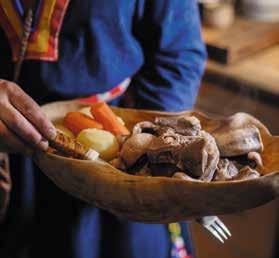


directions: The dinner is set in Eva’s home in central Jokkmokk. www.eolapland.se

50 THE ARCTIC LIFESTYLE MAGAZINE
TASTE
Photo: Pernilla Ahlsén
Photo: Håkan Stenlund
Photo: Carl-Johan Utsi
4 5 6
7
Photo: Pernilla Ahlsén
Låktatjåkko Mountain Station
Sweden’s highest located restaurant, Sweden’s highest located post box, Sweden’s highest located bar, at Sweden’s highest located mountain station, plus Sweden’s tastiest waffles, probably. Much has been written about Låktatjåkko mountain station, but everything really is worth experiencing there, in summer as well as in winter.
directions: Nine kilometres west of Björkliden accessible by foot during summer, or by skis or snowcat in winter. bjorkliden.com

Bondgården Bälinge
Outside Luleå, one of this year’s coolest hotel projects and farm stays is taking place. But already the restaurant, with its own cow-aquarium, is ready and open for guests.
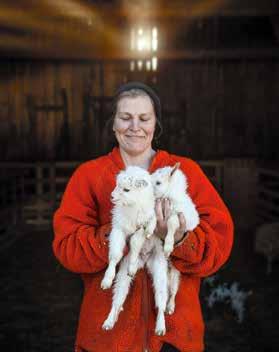
directions: Bälinge lies on the south shore of Lule river, just 14 kilometres upstreams from Luleå along the beautiful road 616 towards Boden. www.bondgardenbalinge.se
Aurora Sky Station
The lift up the mountain Njullá in Abisko brings you to the best location in the world when hunting for the northern lights and eating well. The café has an excellent menu that is served half a kilometre above Abisko – a lot closer to the aurora borealis.
directions: Abisko lies 94 kilometres northwest of Kiruna along road E10. auroraskystation.se

51
TASTE
Photo: Thomas Larsson
Photo: Per Lundström
Photo: Peter Rosén / LapplandMedia
9 8 10
THE WOODS
A breath of fresh air never hurts. That has always been our roundabout way of trying to explain what it is that makes nature good for us human beings. And now science confirms a piece of time-honoured folk wisdom. It’s time for a walk in the woods.
TEXT: HÅKAN STENLUND | ILLUSTRATION: LISA WALLIN
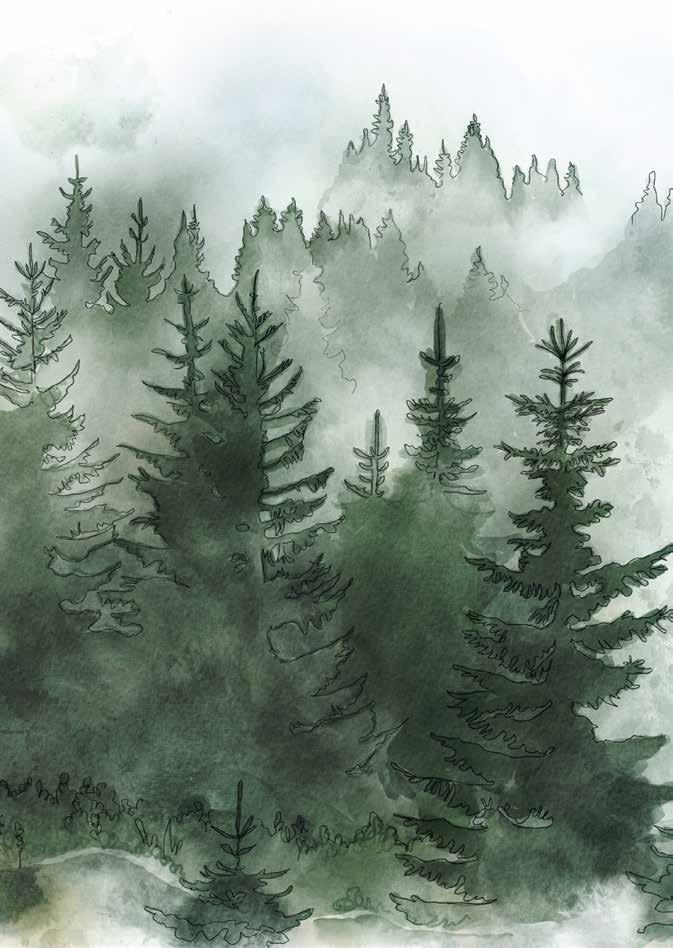
NATURE
a steady, refreshing breeze blows through the forest at Arctic Retreat. Sometimes the wind grabs hold of the treees around the log cabin where I am staying. The trees sway gently in time with nature. Every now and then, slight creaking and knocking sounds can be heard. In a time when we have distanced ourselves ever farther from nature, a hotel room in the middle of the woods is a welcome alternative. I gaze out over a bluish twilight landscape and watch the trees dancing gently in the wind. I somehow feel as if I am out there, part of the scene. Outside a welcoming fire place is waiting, I put my sweater and shoes on, and bring my cup of tea and step out on the porch. For a little while I stand still, simply inhaling and exhaling. I run my hand along the stem of a pine tree. It feels familiar, as a part of myself.
What does it mean to be an animal in human clothing? Author Barbara Kingslover thought this was a question well worth asking. In an age of artificiality, when modern people are more accustomed to the beep of an airport security check than the sound of Hank Williams’s loan whippoorwill, it is comforting to caress a pine limb and hear birdsong. No wonder the treetop bed trend has grown in popularity.
If you ask renowned author and researcher Edward O Wilson for an explanation, the simple answer is biophilia; during our 350 thousand generations here on Earth we have developed a tendency to connect with other living things. And the meaning

NATURE
3 woods worth a visit
of life, according to Wilson, is to find your way of interacting with life – skiing, running, foraging or simply being.
vasikkavuoma
Vasikkavuoma outside
Pajala is the largest haymire in Europe. It boasts a rich flora, fauna and bird life. The area is partly accessible to the disabled. vasikkavuoma.se


of course, there’s nothing hocuspocus about it. It has always been said that a walk in the woods and a breath of fresh air can do wonders for us. But over the past 25 years a growing body of research has confirmed that this does, in fact, have measurable effects on human physical and mental wellbeing.
In Japan, the practice of forest bathing is well established. In a time when there is a Japanese word for “death by overwork”, karoshi, one possible method of counteracting the effects of the latter is shinrin-yoku – forest bathing. Today some 60 specially designated forest bathing parks in Japan are protected from deforestation, preserved to help people to find tranquillity, harmony and new perspectives.
gammelstadsviken
When Facebook established themselves in Luleå they had to adapt the facility to ensure that heat emissions did not affect the climate in Gammelstadsviken. This place is a gem for bird watchers. bit.ly/gammelstadsviken
According to immunologist Qing Li, smelling the fragrance of the forest and breathing in the natural aromatherapy of phytoncides increases our white blood cell count. Another researcher in Japan, Yoshifumi Miyazaki, has shown that the forest has a significant positive effect on our autonomic nervous system. You relax up to 50 percent better in the forest than in an urban environment, and cortisol (stress hormone) concentrations are markedly reduced. In fact, it isn’t really a matter of raising or lowering stress levels when we are in the forest, it has more to do with reaching a normal level. Quite simply, the human body has evolved for living closer to nature.
snow-covered ones, has a positive effect on cognitive function. Professor Hartig has shown that human subjects recover very quickly from fatigue, which is a result of intensive concentration, after a mere half-hour in a natural outdoor setting. Spending 30 minutes of your lunch hour walking in a park or similar relaxing environment can have an extremely positive impact on your physical and mental wellbeing. However, this is not always easily explained or understood.
One of the earliest theories, presented by Kaplan and Kaplan, as to why we feel so well in a natural environment is that this is a simple and undemanding activity. A beautiful landscape fascinates us and we don’t have to focus on it to be affected by it; instead, we need only to immerse ourselves in its restorative qualities. And according to researchers in Germany, among others, Andreas Meyer-Lindenberg in Mannheim, this should be an important consideration for urban planners. For the good of our mental wellbeing we need more and better restorative spaces in urban areas.
for decades, academic research has looked at the forest as a source of value, considering it from the point of view of land resources, jobs and economic security. Stanford University in California is just one of many universities that have taken this approach, but has in recent years broadened the field of forest research to include human-health aspects of nature and forests.
reivo forest reserve
The Reivo forest reserve is located 20 kilometres outside Arvidsjaur. It was created in 1946 because of its unique primary forest. bit.ly/reivo
but it isn’t just being in the forest, or forest bathing, that is good for us. Here in Scandinavia, Professor Terry Hartig, at Uppsala University, has demonstrated that being in wide open spaces, even
What researchers at Stanford have found, in agreement with the above, is that loss of contact with nature is directly detrimental to health. Gretchen Daily and her Stanford colleague, Gregory Bratman, have demonstrated that nature has a positive influence on rumination (repetitive thought focused
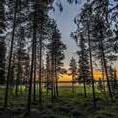
54 THE ARCTIC LIFESTYLE MAGAZINE
Photo: Linnea Isaksson
Photo: Ted Logart
NATURE
Photo: Carina Forsén
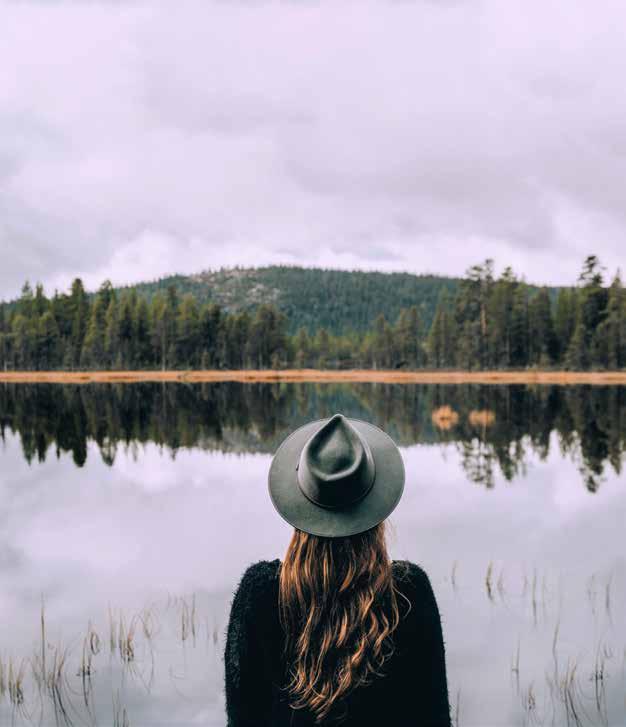
55
Photo: The Common Wanderer
NATURE
“Spending 30 minutes of your lunch hour walking in a park or similar relaxing environment can have an extremely positive impact on your physical and mental wellbeing.”
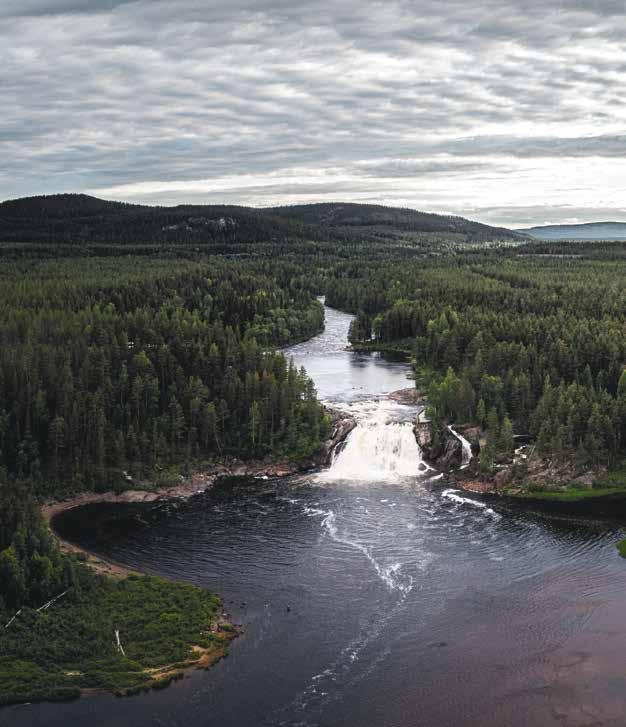
56 THE ARCTIC LIFESTYLE MAGAZINE
NATURE
Photo: Ted Logart

57
NATURE
The junction pool of Ängesån and Lina river with the mighty Lina waterfall.
on negative aspects of the self). In their studies, participants who went on a walk through a natural environment, instead of an urban setting, reported lower levels of rumination. Following the old adage “don’t dwell on the negative” seems to be much easier in a natural environment than in an urban one. Both neuroscientific and purely sociological field studies were conducted.
“We are just discovering how important nature is, while the loss of nature experiences among urban dwellers is enormous. Natural environments are disappearing rapidly”, says Gretchen Daily.
“We must take this into consideration when we create the future. Getting out into nature will become essential”, says her colleague Gregory Bratman in the same programme.
when visit sweden launched a campaign called “The 72 hour cabin”, a case study was conducted. Several people
with extremely stressful jobs – among them a German policewoman, a French taxi driver and a British journalist – were invited to exchange their hectic urban lifestyles for a 72-hour stay in purposebuilt cabins in the Swedish countryside. The results were very interesting. In addition to staying in special cabins made of glass and surrounded by nature, the subjects engaged in typical Swedish outdoor recreation activities such as fishing, hiking, swimming in a lake and cooking over an open fire.
The study, conducted by two leading stress researchers from Karolinska Institutet in Stockholm, showed unequivocally that partaking in the nature lifestyle for which Sweden is known alleviated the participants’ stress significantly. Stress levels, heart rate and blood pressure decreased dramatically during their stay in the woods and their creativity was seen to increase.
Another researcher who has studied
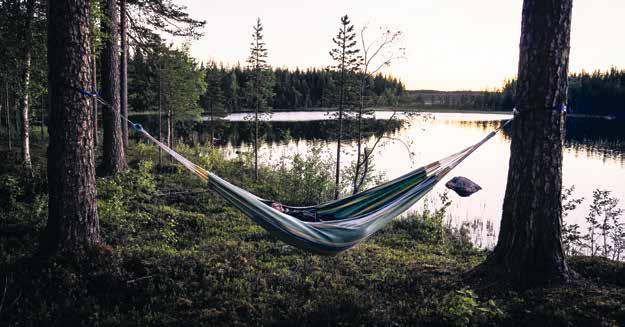
58 THE ARCTIC LIFESTYLE MAGAZINE
NATURE
Photo: Ted Logart
the restorative power of the ‘view to the outside’ is Roger Ulrich, Professor of Architecture at Chalmers in Göteborg. In a study published as early as 1984 Ulrich reported that surgical patients who had been exposed to the natural environment, for example, with a view of a park outside the hospital window, recuperated faster than patients whose rooms overlooked a built environment. After one week of recovery, patients with a view of nature used less pain medication and were discharged about one day sooner than those who looked out on a brick wall.
but is this really surprising? Edward O Wilson popularized his biophilia hypothesis in the 1980s. Biophilia, love of life and all that is alive, is an innate human tendency, according to Wilson. Over some 350 thousand generations the hunter-gatherer within us has evolved, genetically, to love nature. There, more than anywhere else, we feel at home –because it is in our genes. Consequently, each of us must find our own affiliation with nature in order to feel better. For some, it is almost meditative; they simply want to be. For others, like skiers,
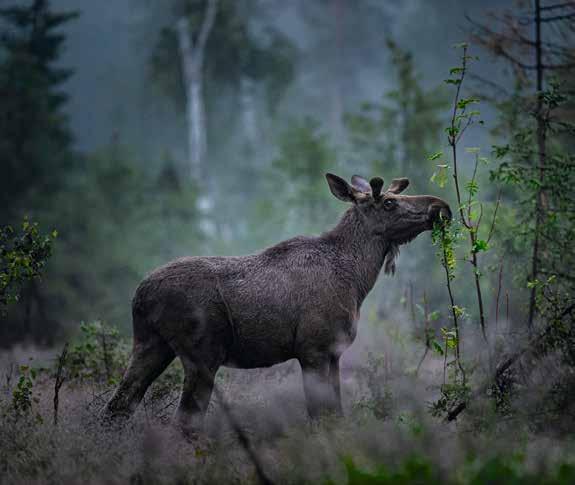
59
NATURE
Photo: Ted Logart
Sources:
SVT, Vetenskapens Värld, ’Frisk av naturen’, September 1, 2019, and VisitSweden.com, ’The 72 hour cabin’.
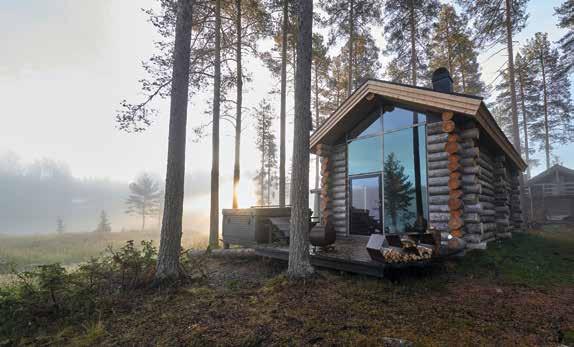
climbers and runners, it is more of a platform for adventure. For foragers, nature is a pantry. The wild berries and fungi they pick taste better than the grocery-store varieties. Whether it is fresh or frozen, you know where the fish and game caught by your own hand comes from. This evening at Arctic Retreat they are serving moose, whitefish and löjrom. Flavours that couldn’t be more local.
If I travel a bit farther inland, to Jokkmokk, I could have a lengthy chat with food entrepreneur Eva Gunnare, who is rediscovering the green kitchen of this Arctic region. We are beginning to understand that something such as bark bread, which once kept northern people alive in times of famine, probably also kept them healthy. Not only wild berries and fungi are edible; more recipes and uses for wild plants, such as angelica, dandelions and euphorbia, are yet to be defined. But rest assured, they will be.
i walk through the woods, running a hand along the trunk of one pine tree after another. According to Qing Li, every time you run your hand along the bark of a tree, substances that benefit the immune system are released. The tree reacts to your touch by releasing an aroma that would fend off an attack by an intruder, an insect or a bird. That this substance is good for our white blood cells may seem like a happy accident, a divine thought or a benign quirk of evolution. The important thing is to welcome the opportunity to benefit from it. Pine bark has a slightly resistant texture when you run your hand over it; yet it is satiny, warm and welcoming. It smells of spring and I am elated. Soothed by the wind that plays among the trees outside the log-cabin, my home for the night. Sleeping in the embrace of the trees, I am as close to the soothing forest as I can get.
60 THE ARCTIC LIFESTYLE MAGAZINE
Photo: Graeme Richardson
NATURE
Arctic Retreat on the shore of the Råne river.
Edible herbs in Swedish Lapland
food entrepreneur eva gunnare shares her favourites: Willowherb has various names in Swedish. One is ‘milk herb’, as the plant was given to cattle to make their milk abundant. In the north, meadows, fields and cleared forest areas are coloured pink in July and the beginning of August. You can eat its shoots as you would asparagus, with a crisp tastiness, both raw and when lightly fried in butter. Fermented leaves become an unusual kind of tea. A cordial can be made from the pink flowers, in the same way you do with elderflowers, and it tastes surprisingly good – like something in between redcurrants and roses. Add some bubbles to it as an alcohol-free alternative!
Rosebay Willowherb (epilobium angustifolium)

Garden Angelica (angelica archangelica)
Angelica, the queen of the mountains, used to be the most important vegetable to the Sámi and one of Scandinavia’s first cultivated plants, and subsequently export product. Its Latin name means archangel and refers to a story first told in the Middle Ages. It was said that archangel Gabriel himself had presented angelica as a herb that was God’s gift to man. Among other things, it was said to cure the plague. Candied angelica is a French medieval recipe, where angelica stalks are boiled in sugar syrup, then dried. Eat and enjoy the mountain sweets!
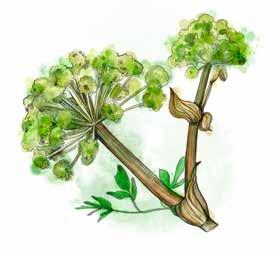
Marsh Labrador-tea

(rhodondendron tomentosum)
Labrador tea, this sprawling, bushy plant is actually a type of wild rhododendron! In early summer, the large white flowers light up the marshlands and their smell is strong and musty. The flowers have been used as a spice in beer and spirits as well as to keep mosquitoes away. The buds used to be sold in pharmacies (Herba Ledi) as a remedy for rheumatism and rash. In small quantities the plant is an aphrodisiac that makes you happy and alert. It is a favourite herb and medicinal plant in the north.
Spruce(picea abies)
Spruce is one of the most common trees in the Nordic countries. Picking and eating spruce shoots used to be a very common practice – they taste fresh and delicious! Spruce shoots are also fully packed with vitamin C, good against a cough, with a taste of spring. Make your own spruce shoot oil: let the tiny, light-green shoots soak in colza oil for a few weeks before straining. A slightly acidic taste of forest, good in marinades, dressings or to add to a mild soup. Or make a lovely forest dip and enjoy it with Labrador-tea flavoured spelt sticks.
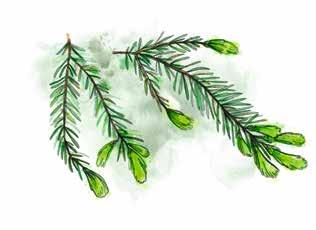
NATURE
Illustrations: Lisa Wallin / Visalisationer
Alpine Bistort (bistorta viviparum)
Alpine bistort is a survival plant worth knowing. It is common in the mountain region and its high carbohydrate content makes it very useful. The sprouts taste like hazelnut when fresh (like the root), but when dried they are crunchy and taste like root vegetables. If you are out and about in summer you can gather these tiny plants and dry them like sesame seeds – to sprinkle on salads and sandwiches, or to use as a spice.
Food entrepreneur and inspirer
Eva Gunnare from Jokkmokk runs the company Essense of Lapland.

Eva Gunnare is one of Swedish Lapland’s most skilled food creators. But where others have invested in developing classical ingredients, such as Kalix löjrom, reindeer and Arctic char, Eva has gone for a different approach. At her home you might be treated to frozen birch sap shots, caramelised angelica or dried northern bilberry. how come? I come from Stockholm originally. But I fell head over heels in love with this place many years ago. Well, the truth is that I fell in love with both a reindeer herder and the place. Later on, I had the chance to develop my interest in food with Greta Huuva in Jokkmokk. Greta was a true tradition bearer. I began to understand what a rich food culture we really have here in Sápmi, but also how it was falling into oblivion. I simply wanted to be part of preserving the traditions, but also developing these flavours.
what do you think is important about food?
Local produce is always right. Visitors want food experiences, there’s enough mainstream back home. When travelling, we all want to experience the local, in our case the Arctic.
do you think we should be more proud of our food and our produce? It doesn’t come naturally to us to talk about the fact that plenty of the best produce is found right here, even if that’s the case. When visitors come to Sweden and want to eat ‘Swedish’, they are often served vendace roe, Västerbotten cheese, Arctic char, reindeer and cloudberries. But we often forget the fact that this is where the flavours come from. My food concept falls within the foraging concept, but I reject the word trend, because foraging has been part of human history since the beginning of time. It is natural.
Scots pine (pinus sylvestris)


A pine forest warmed up by summer smells heavenly. The tree has been important to the Sámi as a much appreciated and healthy complement to meat and fish. In Lule Sámi, the month of June is called biehtsemánno, or pine month. This was when the nutrition-rich inner bark was harvested. The pine shoots are more like an early vegetable, or something children would eat as sweets. Peel away the brown outer casing to find the crispy and acidic light-green interior. Mix dried shoots with sea salt as an exciting herbal spice to season your game meat.
what have you learned from these years as a forager? The clearest notion is that I’ve understood that what I do on a small scale is right, and it works. That’s what visitors want, the real, the genuine and the personal, but above all it’s what the place itself can cope with. I also think we can get better at telling our story, not just inventing something because it sounds good. There are fantastic food stories in the middle of our forest.
and if you were to give advice to others, what would you say? We should definitely invest more in food here in Swedish Lapland. We have all the natural possibilities, with Arctic conditions of few antibiotics and a clean environment. We have both the produce and the story; all we have to do is tell it. Because the flavours do come from here.
62 THE ARCTIC LIFESTYLE MAGAZINE
Meet Eva
NATURE
Photo: Carl-Johan Utsi
The Summer Coast
Not only is the Bay of Bothnia Sweden’s sunniest summer getaway, it is also an exciting destination where the brackish sea water meets lively coastal towns.

63 NATURE
text: håkan stenlund | photo: andy anderson
Photo: Håkan Stenlund
the year was 1944. The world was at war and Allied forces had just carried out Operation Neptune, D Day. At home in Jävre, electrician Elof Söderberg wandered about, wondering what to do with his recent purchase, four hectares of sandy beach on Piteholmen, on the outskirts of Piteå. Back then, land was cheap and a sandy beach had little value, since it produced no timber. Elof the electrician was also an entrepreneur and he soon built a few rental cabins and opened a kiosk that sold ice cream and soft drinks. The war ended and the future suddenly looked brighter.
For three consecutive years in the early 1950s Piteå was Sweden’s warmest place in summer, which soon earned this bathing resort the name “the Riviera of the North”. Fortune smiled upon Elof and people flocked to his beach. Around what was once Elof Söderberg’s ice cream shack, Pite Havsbad has grown to become a full-scale bathing resort and one of Swedish Lapland’s strongest brands. In the warmth of a sunny afternoon the familiar smell of newly lit barbecues drifts among the caravans and motor homes, and the sound of a bottle being opened is heard from time to time.
when speaking of summer, talk of the weather is inevitable. It is an irrefutable fact that the coast of the Bay of Bothnia often tops the charts for the most hours of sunlight in Sweden. This isn’t something that we at Swedish Lapland, a regional tourism organisation, have invented, instead this is backed by official data from the people at SMHI, the Swedish Meteorological and Hydrological Institute, who tell us that summer is, quite simply, best here. And so it has been since the 1950s of Elof Söderberg.
one afternoon, perhaps inappropriately dressed in a Hawaii shirt, shorts and Teva sandals, I drop in at Bistro Norrland, in Luleå. Earlier in the day I took the first boat to Klubbviken, Luleå’s most-frequented bathing beach. The boat ride out from Södra Hamn is a good introduction to tour-boat travel in the archipelago. But that is a whole different adventure in itself. Among young families and sweethearts I have been relaxing with a book on the beach. When it gets too hot in the sun I seek refuge under a café umbrella at the restaurant, where a summer salad and a glass of

64 THE ARCTIC LIFESTYLE MAGAZINE NATURE
Chablis put me in an even better mood. To be without food, good food, and struggle with a bad book are two things you should avoid if you’re looking for the ideal summer. On the other hand, shade, Chablis and a book by Patience Gray can wet the appetite for more.
now and then. At a certain age you start to remember and at all ages your memories become an attempt to make life a bit more exciting than it really was. It could be the time you scored the decisive goal in a division-four football match, something no one has given a thought since then. About the love you’ve had and the love you’ve lost. Or a friend of a friend who became famous. Some might tell you that when they were in school they were at the top of the class, but that the bank clerk job they now hold is no reflection on their cleverness; they simply opted not to “pursue a career”. A noble thought; if only it were half true. Of course, that’s okay, as long as they keep it to themselves. It makes for rather dull dinner conversation. That is probably why I prefer to eat alone, since it allows me to concentrate on what is most important:
the best recommendations from the menu. Fredrik at Bistro Norrland, whom I have come to trust (mostly because he’s a great skier), says he still has a couple of bottles of Pinot Noir from Russian Valley and that these are well worth the money because they are “quite simply, damned good”. Sometimes it’s better with a sommelier who understands people, rather than wine. Someone who can explain in such a way that even someone like me, who seldom gets mired down in terroir, blueberry notes and burnt leather, can understand. Fredrik is right; the glass of pinot is superb and I make a mental note to reserve the remaining bottle for tomorrow. After all, summer will continue. Then I order a well-aged entrecôte, one of my few guilty pleasures in life. I’d rather eat the cow than what the cow eats. Yes, I know. That isn’t much to brag about.
the lost highway. If you take a look at the map, you will notice that relatively few cities in the north are really close to the sea, along the coastal part of what we call the Bay of Bothnia archipelago. Most are a bit upstream from the mouth of the river from which their

65
NATURE
place names derive. Piteå and Luleå are two exceptions. Here, European route E4 does not run straight through the city centre; you have to make a detour to get here. Sometimes I wonder whether this is good or bad. As author Wendell Berry has already noted, we and our senses were not made for travelling on the motorway. We weren’t born moving at 120 kilometres an hour. In summer, more so than at any other time, this is important to remember. In summer, it’s better to go your own way and be “just another guy, on the
lost highway”. There, on the fringe and beyond the mainstream, is where everything exciting appears and comes to life.
I am heading north from Skellefteå. I have been travelling around the southern part of the destination for a few days, visiting farm-stays and farm-gate shops. In the trunk of my car, are cheeses from Svedjan, half a kilo of pork butt from Järvtjärn’s free-range pigs and a side of lamb from Bergsåkersgården. Just to be on the safe side, I also managed to fit a few fresh lamb
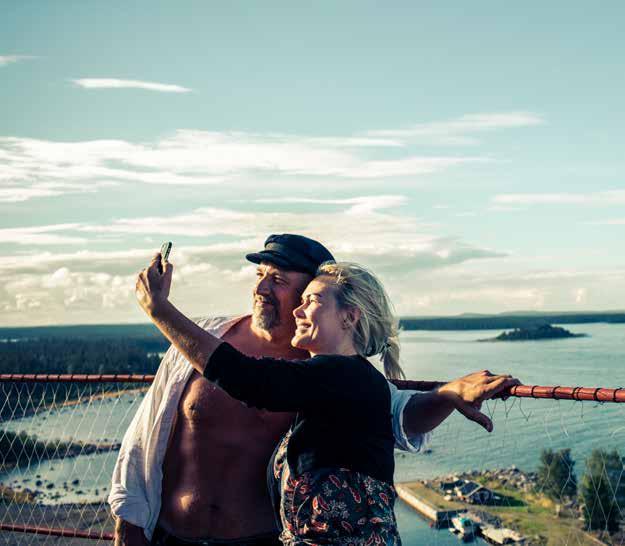
66 THE ARCTIC LIFESTYLE MAGAZINE
NATURE
sausages, a couple of baking potatoes and a six-pack of Kallholmen into my cooler. I think I’m going to manage pretty well in every possible way again this evening. I call ahead to Jeanette at Pite-Rönnskär, but the pilot house is fully booked for the night. But when I ask if it is possible to buy breakfast for the following morning she assures me it will be perfectly all right. So, off I go out into the archipelago, equipped with charcoal, matches and a little food for the evening. I know of nothing better for a summer evening.
at pite-rönnskär a red Heidenstam lighthouse towers over the picturesque fishing village. At 37 metres tall, this is Sweden’s tallest Heidenstam-type lighthouse. In Swedish Lapland there are four of Nils Gustaf von Heidenstam’s lighthouses: three Heidenstam-type lighthouses, plus the fourth, constructed from timber on Malören in the outer rim of the archipelago. After Gustaf, who was chief engineer at the Swedish pilotage service, built his first timber lighthouse on Malören he began to wonder if there was a better, faster way to build lighthouses. That’s when the Heidenstam design was born. It consists of an open iron-pillar tower secured with supports, the design had enormous advantages.

Heidenstam’s lighthouses could be prefabricated, and then shipped out to the site and quickly assembled. Such a lighthouse could be raised in a summer, or even faster. His contribution to Swedish maritime safety cannot be underestimated. Resembling something made from a giant Meccano set, the lighthouses could also be disassembled and relocated. Such was the case with, among others, the lighthouse here on Pite-Rönnskär, which was first erected on Sandhammaren, and the lighthouse which can be seen near the E4 in Jävre, which once stood on Skagsudde. Gustaf designed this master plan for equipping the Swedish coast with lighthouses to make our waters safer. Even modestly well-read Swedes will recognize the name Heidenstam. Gustaf’s son, Verner, part of the neoromanticism movement of the 1890s, was among those who shaped Swedish literature around the turn of the 19th and 20th centuries. Other prominent figures included Selma Lagerlöf (Nobel Prize in Literature 1909) Gustav Fröding and Albert Engström. Verner von Heidenstam was awarded the Nobel Prize in Literature in 1916, which wasn’t bad for someone who was dyslectic and had achieved poor grades in school.
what is often casually referred to as Norrland is, of course, easy to find but hard to define. In fact, the light is what best describes the place. It is the intense midnight light of summer, followed by what many perceive as darkness, but is really just a never-ending spectacle of light phenomena. Polar light, kaamos, aurora borealis and a night sky so full of stars that it feels unreal. In a renovated suite in the old pilot house, on Malören,
67
NATURE
you get a chance to see something that doesn’t happen every day in Sweden.
From the bed you can witness both sunrise and sunset over the sea. Far out on the outskirts of the archipelago lies this atoll-like summer island. The chapel on Malören dates from 1769 and Heidenstam’s first timber lighthouse was erected here in 1851, but the island was inhabited and visited by fishermen and seal hunters long before then. From here, they fished herring, vendace and often caught salmon. Before the lighthouse was built ships sometimes ran aground on this boulder ridge, which is slowly but surely rising out of the sea. The light defines the day-to-day lives of the people, but the ice defines the place.
Here, the tremendous weight of the inland ice once bore down on Earth’s crust. Tens of thousands of years later, this same crust continues to rise into the light of day. The rising land, the effect of a phenomenon called isostatic rebound, is still a factor to be reckoned with. For boats to be able to dock, Malören’s harbour must soon be dredged again. A visit to the far limits of the archipelago is a very special experience. Despite the comforts of modern living, with sunrise and sunset reaching into the bedroom, it still feels exposed.
by boat, it takes nearly an hour to reach Malören from the mainland. That gives you an idea of the distance. But for those who would rather not travel by boat, there are several other ways to get a taste of the archipelago. We’ve already mentioned Piteå Havsbadet. Byske Havsbad is another, Frevisören is a third, and crossing bridges to reach a fourth, the island of Seskarö, you feel as if you are far out to sea. The bridge crossing to Seskarö is a favourite part of the car ride, a bit like Key West meets the Midnight
4,001
4–6
Sun. Your first sight of the bridge promises adventure. Haparanda-Sandskär National Park, the region’s eighth, and only, national park in the sea, lies just beyond. Tour boats call at the island. Here, you can rent a cabin and have a sauna. Above all, there are so many kilometres of sandy beach to wander that you’ll be astounded. You needn’t be a birdwatcher or be interested in plants and wildlife to enjoy the national park; simply bring your swimsuit. But if flora and fauna are your thing, the island won’t disappoint you. On the mainland you’ll probably want to keep that swimsuit on for a dip in the pool at Cape East’s Spa. This is mainland Sweden’s most easterly point; what you see from the terrace is Finland. Haparanda was once a junction between east and west, between Tsarist Russia and continental Europe. It is difficult to believe that a place on what is now probably the world’s most peaceful border was at one time a haven for international spies.
1
there is something special about a border, something definitive. On the other side: another country, another language another time. If you play golf on the course on the Torne River, you’ll know that 11 holes are on the Swedish side of the border and seven are on the Finnish side. Hitting the world’s longest hole-in-one takes, in principle, about an hour and five seconds. From Sweden to Finland in one stroke. At Haparanda Stadshotell, which was built before the Russian revolution, I eat breakfast under crystal chandeliers and with a very tangible sense of history all around me. Over scrambled eggs, I wonder what the day will bring. I have booked a draisine and plan to peddle further inland. A sort of Bombi Bitt adventure for a middleaged Swede who remembers author
68 THE ARCTIC LIFESTYLE MAGAZINE
There are
islands that together create this unique archipelago.
3
per mille equals the salinity in this brackish water archipelago, the only one of its kind in the world.
months every year the islands are connected to the mainland due to the ice, making island hopping easy.
NATURE
metre every 100 years, that’s the land rise in the southern part of Bottenviken due to the postglacial rebound.
Fritjof Nilsson Piraten: “The only danger at sea is land”. I have no choice but to cast off on the voyage, even though danger lurks when you’re having a good time. That danger is the fact that the summer holiday just rolls on, that no new memories are made and that it’s better than no summer at all. It’s a mathematical certainty that childhood summers were much longer than those of middle age. Percentage-wise, the latter take up less space in your memory bank. How lovely it is when things just keep rolling on. I’ve nearly forgotten that I’ve reserved a bottle of pinot in Luleå

when I’m savouring an excellent Riesling together with perch and Kalix löjrom procured on my visit to Seskarö. I park between Karungi and Vitåfors, next to Sweden’s longest stretch of railway for riding draisines. Realising my near miss, I ring the bistro. Fredrik answers and I inform him that I’ve been delayed, but will drop in another day “because a good pinot can’t be missed”. He laughs and says, “You seem to be enjoying yourself, anyway.” I hang up. All I can hear is the sound of summer birdsong and the sizzling of perch fillets on the camp stove. I would have it no other way.
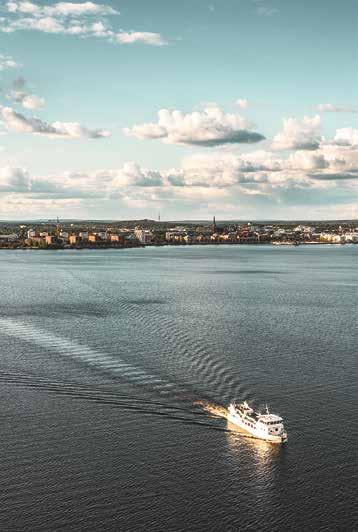
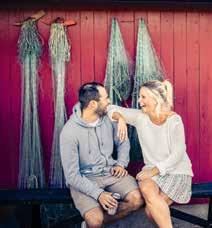
69
NATURE
Photo: Per Lundström

70 THE ARCTIC LIFESTYLE MAGAZINE NATURE
An unbeatable eco–experience
Small-scale, hosting and proximity to nature. Curiosity, knowledge and learning. During her visit to Geunja the Sámi Eco Lodge in the mountain landscape surrounding Ammarnäs, Maria lived in complete harmony with nature. Something happened there, and an inner journey commenced.

71 NATURE
TEXT: MARIA BROBERG | PHOTO: TED LOGART
my first contact with ecotourism was during a visit to Geunja the Sámi Eco Lodge. It is located beyond the end of the road, in the beautiful mountain landscape that surrounds Ammarnäs. Something happened to us there. We left Geunja as changed people, with an unforgettable memory to carry close to our hearts. For a few days, we lived completely in tune with nature: we ate when we got hungry and slept when we got tired. We dozed in the sun on shale stones by the beach and enjoyed the air of the bright summer night. We woke up greeted by pale dawn, watched the wildlife around the corner and listened to amazing stories about Sámi culture. During those days it was like everything else just disappeared.
it is difficult to pinpoint the magic itself. Of course, it had to do with the surroundings: the blue mountains clad in

72 THE ARCTIC LIFESTYLE MAGAZINE
NATURE
”Regardless of which: this is sustainability in practice. Buildings that can be removed without leaving a single trace.”
tiny mountain birches, the crystal-clear water and the sea of flowers: alpine sow-thistle, angelica and the straightbacked monkshood. It was also related to the gentleness and quality that permeated everything, from buildings to the guided tours; and it was about the warm, lovely hosts and all the things we learnt along the way.
Our hostess would perhaps point to ecotourism as the crucial ingredient and common denominator – a certain approach to the surrounding culture and nature that provides guests with a more in-depth experience.
another part of Swedish Lapland, in the middle of World Heritage Laponia, is home to Sápmi Nature Camp. Just like at Geunja there are cultural buildings here, but instead of Geunja’s southern Sámi peat hut and greying timber buildings, Sápmi Nature Camp is made
up of northern Sámi tent huts. Regardless of which: this is sustainability in practice. Buildings that can be removed without leaving a single trace.
Lennart Pittja, the founder of Sápmi Nature Camp, says he made the connection between ecotourism and reindeer herding at an early stage. He explains its importance. He is not a reindeer herder himself, but the reindeer is one of the things dearest to him, alongside his love for his children.
“The starting point is very important. I try to create an experience without destroying more nature. In my mind this means small-scale and responsible, but also a lot of fun for the guests”, Lennart tells me when I ask what ecotourism means to him.
“I like small-scale, and the one-toone meetings you’re awarded when you work with something like this. I get to travel a lot without moving from the spot; I travel by conversation as we’re sat talking at the dinner table, and I get to learn much about the world this way. It feels like a waste of time to travel far and not being able to meet people. It’s unnecessary to promote mass tourism when there are better ways to travel and to experience things”, Lennart says.
The dinner table in question is found inside the log cabin next to the tent huts at Sápmi Nature Camp.
the location is Sjávnja nature reserve, by the beach of Stuor Julevädno, within the Unna Tjerusj reindeer pasture area. Lennart is connected to the Sámi herding cooperative, of course. It is an important principle in ecotourism work.
“Local connections and the relationship I have with the herding cooperative for the business I run inside their reindeer pasture area is an important dimension that more people should be striving

73
NATURE
for. You can enhance your product just by sharing knowledge and experiences at an earlier stage”, Lennart says.
“Recycling and and non use of plastic cups, environmental considerations, those kind of things are easy to measure. But it’s all very basic: it’s ethics we should be striving for, and do better. Sure, not using plastic cups and recycling are parts of ecotourism, but rather small parts. Sustainability is a much larger concept and you can’t pick and choose, or forget parts of it. Local connections, local economy, environmental consideration, safety, respect and responsible travel create a whole, providing eco-tourism experiences.”
so what does it mean for Lennart to be an ecotourism entrepreneur? Well, he tells us, it provides a better experience. It grants you a greater understanding of the impressions you encounter as a guest. He takes the Sámi culture as an example:
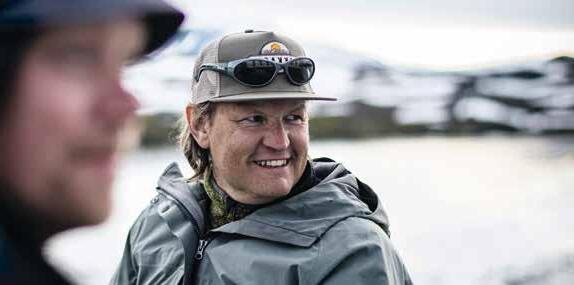
“I think it’s often something that’s there as a backdrop. It’s one of the
reasons people want to visit, but often it can be difficult to meet Sámi people. What my guests get as part of the experience is spending time with Sámi people who want to, are able to, and have time to tell them about their lives. They get to ask questions that you won’t find the answer to by visiting an exhibition or a concert”, he says and continues:
“There is something there, in the oneto-one meetings my guests describe, that they are very happy to have been able to experience. They get to learn a lot in the bargain, and I think that’s getting more and more important these days.”
“A common denominator among all those I know who offer this kind of experience is the small scale of things and the one-to-one meetings, and that we contribute to providing new knowledge. I’m completely fascinated when I get to travel and visit other businesses involving local experts who want to and are able to tell stories about that place and its culture, about what we see and experience. It’s something that’s inspiring to be part of.”
74 THE ARCTIC LIFESTYLE MAGAZINE
NATURE
Lennart Pittja




75
Ammarnäs Wärdshus
Sápmi Nature Camp
Tjuonajokk
NATURE
Geunja the Sámi Eco Lodge
back in ammarnäs midwinter has released its iron grip of the valley and the sun has returned. It is spring winter, gidádálvve. At Ammarnäs Wärdshus, located on a hill in the middle of the village, the owner Per Jobs tells me about other activities related to the restaurant taking place during spring. It was the fishing that led him to Ammarnäs back in the days. He now runs two great establishments in Swedish Lapland, both of them with a history as well as a good reputation: Tjuonajokk at the Kaitum River in Gällivare, and this one in Ammarnäs. They are both strong on nature-based tourism, for birders, fly fishermen and hikers. This is places you desire.
Here in Ammarnäs business has expanded since Per took over Wärdshuset, and there are other activities than fishing on the agenda. The ecotourism approach is always there as a base, whatever he or his co-workers do. It means taking responsibility, he says. He compares Ammarnäs and Tjuonajokk, two different places with different conditions.
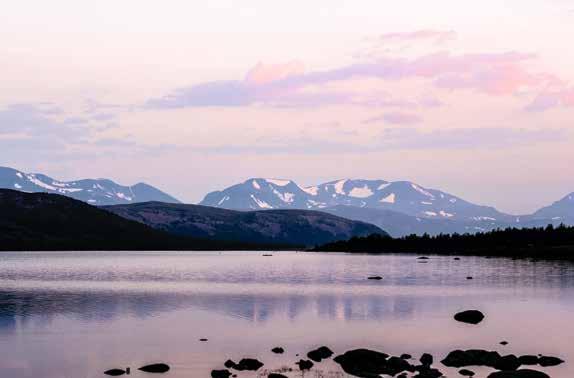
You have to be aware of the location’s inherent limitations and strengths, he says. And you have to give something back. It’s important not to wear down the surroundings or those who live there.
“There are too many tourist resorts that end up ruined where the locals are being pushed away and nature is destroyed. What kind of experience is that? It’s not genuine.”
“You travel to this kind of place to experience all that is unique about it: the natural surroundings, the culture, the people. That experience must remain.”
per tells me how different his businesses are. The differences between Tjuonajokk and Ammarnäs might not look big on paper, but running a business in a village is not the same as running a business in roadless land, and each place is unique.
A prerequisite to his activities in Ammarnäs being successful is that the village survives. It’s all connected, he says. He wants to help develop the place. And if you travel as an ecotourist you
76 THE ARCTIC LIFESTYLE MAGAZINE
NATURE
contribute to the local community.
“There is another aspect to it, which is the learning that the ecotourism journey entails. We create curiosity and knowledge, and as a guest, you become aware of a reality that you didn’t know existed. What you’re not aware of, you can’t protect. We create little activists,” he says.
it can be said that Swedish Lapland truly equals ecotourism. Here you find small-scale establishments, generous hosts and proximity to nature. In Ammarnäs it is even more tangible, where people have worked with sustainability for a long time. Many of the businesses here are ecotourism establishments. In fact, Ammarnäs has the largest number of ecotourism businesses in Sweden.
If I have not made it clear yet, I will say it again. Travelling as an ecotourist is something beyond the ordinary. Per Jobs agrees.
“It’s about starting an inner journey. To be able to look at reality from a different perspective. That kind of experience does you good”, he concludes.
what is ecotourism?
• Ecotourism is a way to immerse yourself in nature and culture without ruining what you have come to experience and to actively contribute to the development of the places you visit.
• By choosing ecotourism you actively contribute to nature conservation and preservation of cultural values.
• Ecotourism entrepreneurs work towards stimulating a joy of discovery and curiosity.
• Ecotourism means that all activities are adapted to the limitations of the destination, but – just like other forms of tourism – they are all about having fun and getting memorable experiences.
• There are certified companies, and companies without certification. In Sweden, the main ecotourism certificate is ‘Naturens bästa’ (Nature’s Best), a quality label for eco-tourism jointly created by the Swedish Ecotourism Association and Visit Sweden, with some 60 approved businesses, of which a large number are found in Swedish Lapland. Choosing a certified business you are guaranteed a high-quality nature experience.

77
”You travel to this kind of place to experience all that is unique about it: the natural surroundings, the culture, the people. That experience must remain.”
NATURE
Mikael Vinka
From Joik to Airijoki
in the late 1990 s , The Wannadies released their compilation album Skellefteå, named after their home town. Where wet green grass meets dust and dirt / that’s where love no longer hurts, Pär Wiksten sings softly in My Home Town, the song that became a theme song for the coastal town. My Home Town is really about love at a distance. But I still imagine that The Wannadies describe Skellefteå as they saw the town back then: just strolling around in the streets filled with the dust of summer, in a town that seemed like it would never change.
I am familiar with that feeling too, of course. It is the teenage mantra of sleepy industrial towns: “there is nothing to do here”. Just pop music, ice-hockey and factories. Even though we were jumping to rock music during street festivals, music that sounded larger than the places it was rooted in. It was music that was aching to go, and we wanted to leave with it.
something has happened since then. This is a different decade, well, a different millennium to when The Wannadies released Skellefteå. Moving to a big city to live the creative life is no longer a matter of course, and it is no longer mandatory to write about this part of the country as something that was left behind and never changed.
For those of us who listen and read, this means that we get to hear other voices and get to experience other realities, people and places through them – voices that rarely find a place in popular culture. Jokkmokk-born Kitok, for example, is usually described as “a voice for the countryside”. He really enjoys singing about his roots and his Sámi identity, a Jokkmokk and a northern region that is a metropolis in its own right. But there is also an ambivalence in Kitok, a friction between city and countryside that he best describes himself in “Inland Empire”: Too Norrland for the city and the other way around / but see how far I’ve come. Another example is joik singer and artist Sara Ajnnak from Gargnäs who recaptures her Ume Sámi language and lets her own life be the starting point of her songs: the legacy of forced displacement, the land exploitation, being a Sámi woman.
the author elin anna labba, who lives in Jokkmokk, is one of the more successful. She portrays the forced displacement in Sápmi and tells the story of a black chapter in Swedish history, with the help of voices all around Sápmi that have not been heard, in her debut book Hearrát dat bidje min: Bággojohtimiid birra (‘The gentlemen put us here’, Norstedts 2020). It was awarded the August Prize for best non-fiction
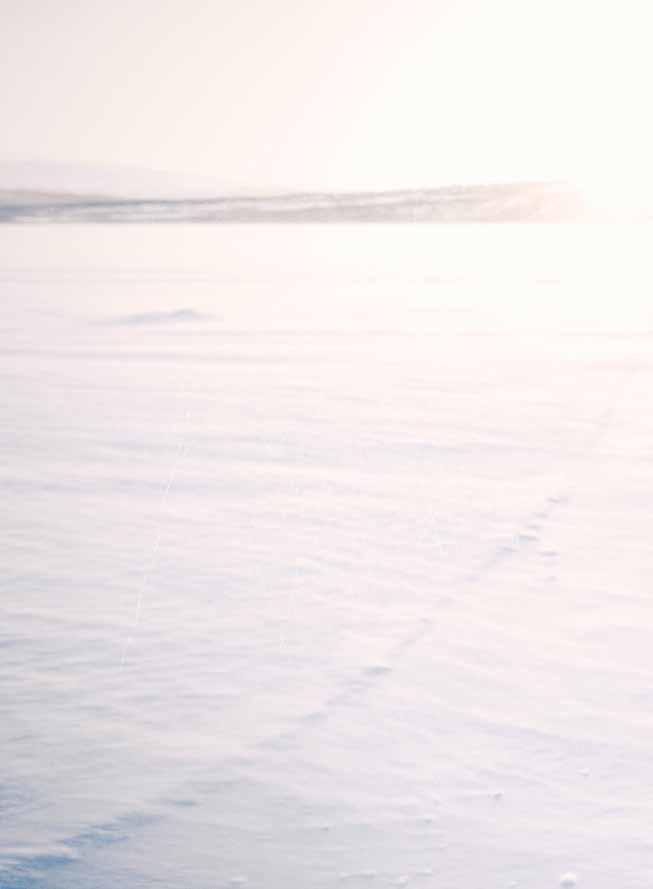
78 THE ARCTIC LIFESTYLE MAGAZINE CULTURE
TEXT: MARIA BROBERG
Telling a great story has always been important. In fact, some claim that homo sapiens thrived as species due to their skills in gossiping. From jojk to Airijoki, from stories to songs, this place is known for a good vibe.

79 CULTURE
Johan Airijoki
Photo: Anthony Tian
book of the year that same year. Elin Anna is my publishing colleague; I also made my debut at Norstedts in 2020 with the novel Troubled water, anchored in my place on earth, at the edges of the river Vindelälven near Sorsele. I would also like to mention debutant Moa Backe Åstot, living in Jokkmokk. Her debut novel Sky on fire has been well received. The list could go on, but I will end it there.
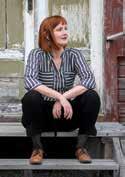


Around Swedish Lapland, other musicians and authors master their language and artistic expression, with their feet firmly placed in the culture and geography that shaped them. As if there is an insight now that it is possible to be something different and tell stories about what is ours: as if you are plugged straight into the do-ityourself attitude that runs through the northern countryside like an artery.
it might be in gällivare they do it best. This is home to two people who have clearly placed Lapland as the axis of the world – centre and periphery at the same time – in their creations: poet David Väyrynen and musician Johan Airijoki. Both of them seem to have derived their language and expressions from the ore-rich bedrock.
David Väyrynen published his debut Marken (‘The ground’) in 2017, a kind of literary catalogue of the sparse countryside in the north in both form and content that attracted a lot of attention. Not far from him we find artist Johan Airijoki, who once described his songs as “stories from the ground floor”. He is a rock musician who sings about working shifts, vodka belts and silence, about forest clearing and snowmobile trails and marshland, allowing the larger philosophical questions in life – class, masculinity, the betrayal of the big
society – to be glimpsed among words that are so straight to the point they sometimes leave me blushing.
“hold on, I’m just going to take a snus”, says Johan Airijoki when I call him to talk about what happens when you create music about a place like Gällivare and the people and nature there.
It was only when Johan moved back after a few years studying in Umeå that he found his place, he says when the snus is firmly in place, and I cannot help but think of some lines from his Afterski-Ikaros: ‘I bought myself a leather vest and started using snus to be free / I moved home to Lapland and played covers at after-ski / Because I fly towards the sun and the guitar it sings with me.’
“When I moved back home it felt like a lot fell into place. I had an idea about what kind of music I could be doing and what expression it would have. In Gällivare there is a lot of rock and rockabilly”, he tells me, “and an American car culture. There were other local things too, like the dialect, and the typical jargon.”
“It was an interesting mix. It was something I hadn’t heard before and it meant the music worked well. It felt wonderful and raw, for real.”
so far johan airijoki has released three full-length albums under his own name and a fourth is in progress. Those released so far revolve around what it means to be a person in his surroundings, among motor homes, inland petrol stations and moonshine makers. I have no reason to believe that the fourth, in production, will be any different, but I forget to ask him about it.
The stories are taken from his everyday life, everything happening around him and sometimes inside Johan
80 THE ARCTIC LIFESTYLE MAGAZINE
Photo: Sandra Hansson
Photo: Andreas Nilsson
Photo: Carl-Johan Utsi
CULTURE
From the top: joik singer and artist Sara Ajnnak. Middle: author Maria Broberg. Bottom: author Elin Anna Labba.
himself. He brings the listener down into the mine, out into the marshland and pine forests, with eyes towards the mountains and the illuminated town streets. The surrounding nature is present in many of Johan Airijoki’s lyrics. I myself do not think of them as romanticising – but when I ask, he defends himself.
“Actually, I am a romantic son of a gun. But I definitely don’t want to do some kind of postcard art. It has to be abrasive, in some way. To many up here nature isn’t just a place where you have fun and relax, it’s a workplace too, and a place where you get food and firewood.”
the stories on En blyg viol (‘A shy violet’, 2018), Allting kommer att bli bra (‘Everything will be fine’, 2017) and Vissa saker måste brännas (‘Some things must be burnt’, 2015) are both poetic and documentary. He is observant as a person, he says, attentive to moods and impressions.
“I’m quite good at creating meaning. I can create a story about things that people might think are small and trivial.”
As in Meter och ton (‘Metre and ton’) where a scruffy little fox with scabies, running among the song lines, comes to a standstill. An image that summarises most things that needed to be said right there.
“There isn’t much said in popular music about my context, in my generation. It’s not crowded. There’s a lot for me to interpret”, he says.
What he is portraying is a place that is so different to live in, compared to a big city. It could also be perceived as strange and exotic, especially since the place is so unexplored, in terms of pop culture. But, Johan says, people are people.
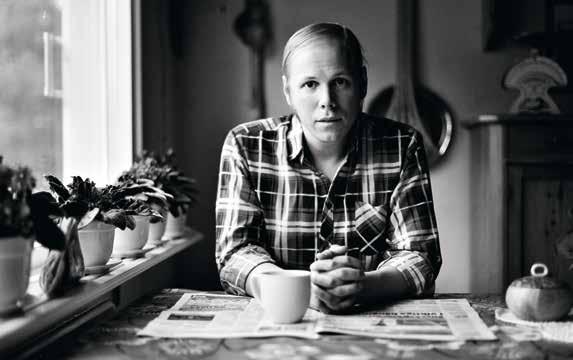
“If you just find something that’s honest and interesting you can relate to it, whether you live in Gällivare or Stockholm’s inner city.”
It’s just that these stories haven’t been used that much, nothing has become worn.
“There are some pop and rock clichés that I try to translate into my own context. Like Vodkabältet (‘The vodka belt’). It could have been an American rockabilly song about drinking whiskey, but I sing about our alcohol culture and drinking moonshine.”
81
CULTURE
Photo: Daniel Olausson
David Väyrynen

82 THE ARCTIC LIFESTYLE MAGAZINE CULTURE
Photo: Anthony Tian
“I’m trying to nuance the image of the man from the north, which is quite a limited image. ”
musically, he seems to move seamlessly between extremes. On the one hand rockabilly, rock and blues, on the other hand you can sometimes hear indie and finely-tuned folk music. When I ask him about it, Johan says there is a musical curiosity in him, that he is into several different kinds of music genres. He listens to everything and some things might stay with him.
“The people I play with are also very interested in music. Some have studied jazz at college, the bassist plays in a country band, the guitarist has a death-metal band. It’s actually a freedom when you live in Gällivare, you can do whatever you want, there’s no scene to belong to and nothing to measure yourself against. We pick and mix the things we like.”
The lyrics and the music are created in unison, Johan says. He starts by playing and looks for a feeling, some kind of core, in what he is playing. You have to find the kind of lyrics that feel right in your mouth, he continues, that you feel are honest, and that you can stand behind when you stand on stage.
“I try to whittle it down – the lyrics should be as straight as possible. Rock music can’t be wishy-washy, it has to be straight shooting”, he says.
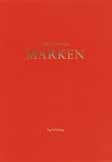

It is straight, sometimes rough. ‘Stories from the ground floor’. A critic who fails to listen carefully might call it excessive, possibly also stereotyped. But in places it is also very delicate and fragile.

“I’m trying to nuance the image of the man from the north, which is quite a limited image. You’re supposed to be tough and take it, hunt, wear a flannel shirt and work, there’s nothing else. I’m quite a sensitive person and I notice that people around me also have an emotional life. It’s almost forbidden in a way, you shouldn’t go poking into that kind of stuff. It’s a rather fragile masculinity and there’s something very vulnerable about it that I try to describe.”
while talking to johan I think of the pride he seems to feel. I want to describe his music as honest and open, a kind of upright decision to be the man you are, where you feel at home. It is not music that sounds larger than the place it is rooted in, instead it is music that is interesting and exciting because of its geographic and cultural origin – and of course its creator’s entire person: the shy violet who stood up and flew towards the sun, in the company of his guitar.
“Yes, I feel great pride. I haven’t always. What I feel proud of is that I don’t compromise on how I speak or how I express myself, that I’m proud of where I come from, that my roots are in the Tornedalen and that I know my own history. I’m proud of that.”

perhaps it is that pride that makes it different. A pride of northern roots, language and life, what is special about here that cannot be found anywhere else – what the ice-hockey fans at Skellefteå Kraft Arena have understood and express as they roar My Home Town with all their heart. The pride is undeniably there. From Kitok, who lets home be just what Paradise Jokkmokk is, to David Väyrynen who transmits everyday life in Gällivare in a way that appeals to many. From mountain to coast via Sara Ajnnak, who raises her chin and looks straight into the camera in the music video Reäjnnuo neäjdda
Always proud. From The Ground to ice-hockey. From rock to hip hop. From joik to Airijoki.
83 CULTURE
Hearrát dat bidje min, published 2020, Norstedts.
Himlabrand, published 2021, Rabén & Sjögren.
Bakvatten, published 2020, Norstedts.
Marken, published 2017, Teg Publishing.
Photo: Pär Olofsson
The KING of all trails
Kungsleden is one of the world’s most famous hiking trails. Through Sweden’s vast and wild mountain scenery the trail provides some 450 kilometres of hiking adventures. This is an ode to the trail.

84 THE ARCTIC LIFESTYLE MAGAZINE NATURE
TEXT: HÅKAN STENLUND | PHOTO: TED LOGART

85 NATURE
sweden’s most famous hiking trail, Kungsleden, initially went from A to A. From Abisko to Ammarnäs, or vice versa. It was not until 1975 that the trail was extended to go past the King’s fishing spot at lake Tärnasjön in Sorsele municipality as well, and on to Hemavan. The Swedish Tourist Association (STF) began working on the Kungsleden back at the turn of last century, and in the STF yearbook from 1900 you can read about it, marked on a map: “This will become the King’s Road through the Lapland mountain world”. 75 years later it was all ready to go and in 1977 the trail became part of the state mountain trail system. But it was not a case of STF creating a brandnew trail for the state system – there were old hiking trails that were joined together to create a ‘royal vein’ through the mountains. Indigenous people and others walked here for thousands of years before anyone came up with the idea of a signposted trail.
these days, the stage between Abisko and Nikkaluokta is the most hiked trail in all of Sweden. The stage Abisko to Hemavan also gets a lot of visitors, but between Ammarnäs and Jäckvik there are not quite as many who wander. And between Jäckvik and Kvikkjokk, it mostly comes as a surprise if you come across other hikers. But you are not alone. There is history here, and nature: other cornerstones of human life.
wrote: “The path is made in the walking of it”. What you dream of as freedom is the choice of the collective, in a way. Simply because it is the right way to go. Ideally, a path works as a helper, someone who discreetly shows you the way as the world just opens up. Surely that is why the path or trail in literature, philosophy and religion has always been a metaphor for man’s inner guidance.
zarathustra spoke of the threefold path: good thoughts, good words and good deeds. Siddhartha Gautama spoke of the eightfold path to nirvana. Tao basically means trail. The Hebrew word for Jewish law, halakhah means the walking, and the Islamic law, sharia, can be translated as the path to water. The Bible is of course also full of stories about people taking the path up the mountain, or through the valley of the shadow of death. The Psalms state that the word is “the lamp unto my feet and light unto my path”. But on your way between Kvikkjokk and Saltoluokta it is not very likely that you will be struck blind by a light and converted like Paul, even if you are walking in the midnight sun. The most important thing is that you stay on the road and keep walking. Because on the Kungsleden a spiritual path is not much more than the ground in front of you, worn clean down to rock, gravel and dirt. Something you put your feet on because you want to get from here to there – because possibly you will encounter your new interpretation of things, something that will make you see the world as a little bit more beautiful.
ZHUANG ZI
a hiking trail, what is it – really? For most people who set off on a hike, or even a ‘thru-hike’ of the entire Kungsleden, there is a dream of freedom. But as you find yourself on the high plateau at Stabburet above Ammarnäs, with large swathes of Vindelfjällen nature reserve – one of the largest in Europe – in front of you, you realise that the trail does not provide oceans of opportunities at all. Instead, the trail reduces your flow of opportunities to a trickle: if it had not been for the path you are walking, you could have chosen a billion different options where to put your feet. As Zhuang Zi
vindelfjällen mountains is one of Europe’s largest nature reserves; allegedly there is one somewhere in Russia that is larger. The Kungsleden runs like an artery straight through the reserve, from Hemavan towards Arjeplog and Norrbotten. When you have hiked the first 100 kilometres between Hemavan and the Norrbotten border you have walked through two municipalities, and there are four municipalities to go before you get to Abisko. Ludmilla Wieslander works at Naturum in Ammarnäs. She comes from Lund, in the very south of Sweden, but came here for an Easter break and her heart stayed put. First at the bar at Ammarnäsgården with a handsome man, then in the beautiful location itself.
86 THE ARCTIC LIFESTYLE MAGAZINE NATURE
“The path is made in the walking of it”


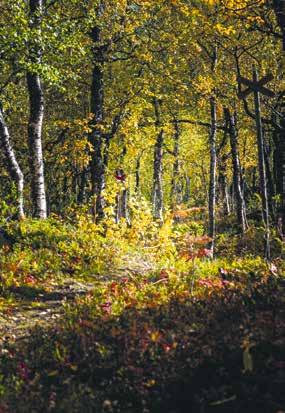
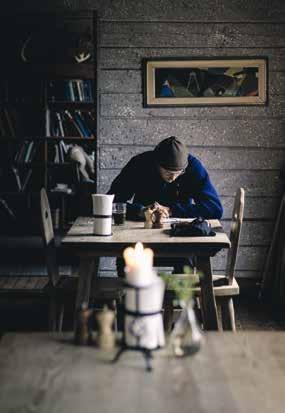
87 NATURE
Elin Strannegård at STF mountain station in Saltoluokta.
STF mountain station in Saltoluokta.
“Yes, to me Ammarnäs is the very heart of Vindelfjällen. The day-trail loops as well as the two big trails Kungsleden and Vindelvaggeleden, like two massive blood vessels through the reserve, they all start from the village in one way or another.”

“The nature is amazing, this place is stunning, and in the middle of all this, the beating heart: Ammarnäs.”
the vindelfjällen nature reserve is large, as stated, and its preservation is based on many different things. This area is not just about hiking, it is also home to some of the finest bird watching in the mountain world. The University of Lund runs one of the world’s longest-running bird-observation projects here: the Luvre project. Every year the red-listed lesser white-fronted goose visits the village for a stop before the birds fly into the mountain world. The reason for the Luvre project and other nature projects in the area is that the nature in Vindelfjällen changes on nature’s own terms. Even if it is not a wilderness per se –people have lived here for 8,000 years – it is a cultural landscape that changes very slowly. It is difficult to talk of a wilderness when you are hiking on a trail that
is equipped with footbridges and marked with cairns. But there is something enchantingly wild and beautiful about the seemingly endless landscape. As if it should always be like this, because it has always been like this.
in 1949 Aldo Leopold wrote his classic book A Sand County Almanac. It begins: “There are some who can live without wild things, and some who cannot”. No one has really explained it better, why some walk, fish, go out into the woods – and why others do not. Without the dream that the wild is needed, there is no need to go looking for it. Perhaps it is as simple as that – two types of people: those who are looking for nature and those who are not.
Somewhere above Ammarnäs, some fifty metres from the Kungsleden with the Björkfjället mountain behind you and Arjeplog municipality and mountain world before you, you set up your tent and ponder the fact that there are just over 300 kilometres left until you reach Abisko. The Kungsleden will guide you step by step along the way. The area in front of you has basically been the same since the end of the ice age, and in this kind of nature the process of evolution
88 THE ARCTIC LIFESTYLE MAGAZINE NATURE
is a matter of course. No plants grow here without reason, merely to decorate the landscape. If they are able to grow here, they grow where they can, to feed the animals who need the plants that grow. In many ways this is a place defined more by body than soul. You have to be strong to get somewhere; just thinking about it is not enough. It is only really the wind itself that has explored this landscape, everything in front of you, in detail.
a path is created based on a need. The easiest way to discover this is among city blocks. People will not follow a paved path if it fails to support people’s need. Between walkways drawn by city architects, nature paths are shaped by people’s laziness, and these so-called ‘desire lines’ will soon create short cuts and simplifications. Our feet understand this, the pen being traced across the drawing board does not. The new routes become a graffiti of the feet, protesting against what the authorities believe they drew and planned. No trails are drawn on the mountain. From the beginning, human feet followed paths created by the hooves of animals, then those feet made their own short cuts,
and the path became more and more defined. Not just as a thought – a “King’s Trail” from A to A – but a reality. In Japan these paths are called kemonomichi, animal paths, while the Dutch have given the animals a persona in olifantenpad, elephant paths. What is clear is that if a hiker walks a path and other hikers find it worth following, the collective will make the path better and better, together, or at least more adapted to the hiker’s needs.
roadless land. That is what it’s called, the landscape beyond the car park. But in the middle of this roadless land there are some really big surprises. A place to sleep, a shower, a sauna and a cold beer with your meatballs at Bäverholmen Inn. Or at lake Riebnes, after catching the boat ride to Vuonatjviken with Jan Johansson, when you decide to stay for dinner. Everything here is basically as locally produced as it gets, by the family that has lived here – on the Arctic Circle – for generations. Moose, arctic char, reindeer and cloudberries. Nature’s pantry around the corner. It is impossible not to think about the hardship that must come with living like this, away from it all.

89
NATURE
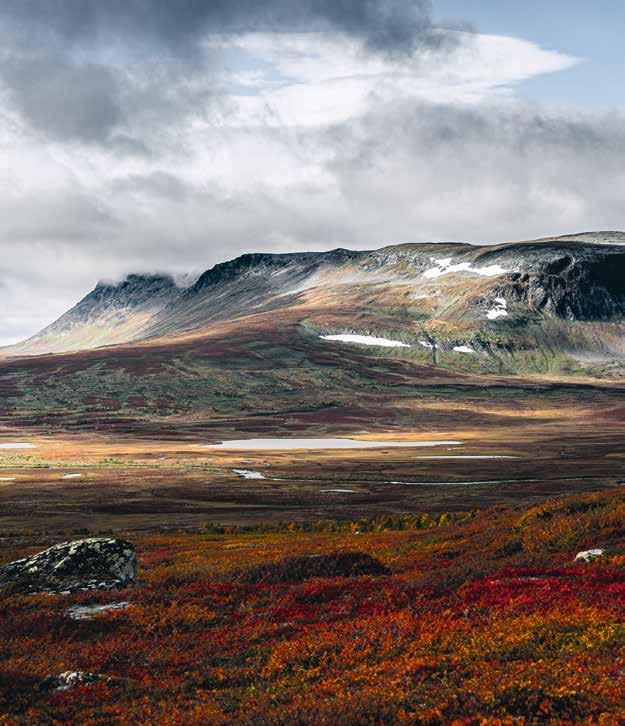
90 THE ARCTIC LIFESTYLE MAGAZINE NATURE
“You don’t forget to buy sugar more than once in your life, if it’s sugar you wanted. There’s such a long time in between shop visits”, says Janne and continues:
“But, as I’m sure you understand, our needs are different, and it would have been a lot tougher for us to live in the city. We have no traffic jams here and the problems are completely different. We mostly choose those problems ourselves – as long as they’re not caused by nature.”
Since restaurants are few and far between in roadless land you have a three-course meal this evening, before the trail leads you further. Alone.
there are questions you will always ask yourself as a hiker. It is about the physical person as well as the inner person. About blisters and doubts. They say you only start feeling like a proper hiker on the tenth day. That is when your body starts to feel like it is made for it. It is not an obvious or easy thing to manage ten days in a row on the trail. Some have the feet for it, others do not. “A woman is as young as her knees”, wrote Mary Quant, and Polish philosopher Stanislaw J. Lec wrote “He who limps is still walking”. The main thing to overcome is the comfort of the sofa. Another question that always comes up is whether you should hike on your own, or with someone else? From a safety perspective it is better not to go on your own. But perhaps it is safety you want to get away from? An Irish proverb says that “two shorten the road”, while Henry David Thoreau crassly states that “the man who goes alone can start today”.
When Jeremias and Hannah, from Northern Soul Journeys trotted along the whole Kungsleden a few years ago, they did so as a new couple. They also decided that they would each carry a part of the essentials in their packs, so they had to do things together when the day was over. No one carried the whole tent, or the entire kitchen; they had to make camp together for the night. There is something beautiful in that thought.

food occupies the mind of many hikers. Dreaming of what will be on the plate when the hike reaches the end of a stage, or is finished, even.
“You get the best burgers at Björk in Hemavan, but the souvas-smoked burgers at Guidecenter in Ammarnäs and the burgers in Saltoluokta are tasty, too.”
91
NATURE
Jeremias Kinnunen at Northern Soul Journeys likes to talk about the burgers he has eaten along the Kungsleden. A couple of years ago, as said, he hiked the entire length of Gröna bandet with Hannah, but it is the burgers of the trail he remembers when we ask him about the experience. And his favourite stages.
“It is a bit strange, but the trail between Ammarnäs and Jäckvick is one of the least hiked stages of the King’s Road. But it is amazingly varied and beautiful, walking down Björkfjället mountain through Stijguojá, across Pieljekaise national park towards Jäckvik.”
“It’s as if the Kungsleden has everything right there. Even some burgers.”
reindeer calves do not need to be stressed for a selfie; it is difficult enough for them already in a land that is only truly known by the wind.
“you can definitely tell the difference between a thru-hiker and someone who’s only here for day trips and food”, says site manager Elin Strannegård at the STF mountain station in Saltoluokta.
“You can tell from the hunger, and the packs. They have a lot of the first and little of the second.” Saltoluokta has become a luxurious destination along the Kungsleden. It is easy to get here, travelling by car and boat all the way, and there is an incomparable view of Lake Langas and Stuor Muorke national park in the ambitious restaurant. This is why Saltoloukta gathers lovers of life and mountain veterans in a great mix. You can feel it when you leave the mountain station behind, that you really wanted to stay.
along the trail you pass some of Sweden’s most famous nature areas, as is to be expected. We have already mentioned the Vindelfjällen nature reserve, but the national parks Pieljekaise, Sarek, Stuor Muorke/ Stora Sjöfallet and Abisko are also part of the trail. These four national parks were involved when Sweden, as the first country in Europe, set aside land for nature conservation on May 24, 1909. Sarek and Stuor Muorke has since been joined with Padjelanta and Muddus national parks to create Laponia, which due to its unique nature and culture was designated a World Heritage Site in 1996 by the UN agency Unesco.
Along the entire length of the Kungsleden, you are hiking through Sápmi, the land of the indigenous people. On the trail between Hemavan and Abisko you walk through the reindeer grazing land of fifteen different Sámi economic associations. Some parts of the year, calf branding takes place in the mountains. During other times of the year, reindeer are gathered for other purposes. Always be considerate and remember that you are in the middle of Sámi everyday life, as well as at their workplace. In summer, newly born
sooner or later, we will all hike to Abisko. It is the most popular stretch of Kungsleden, especially with the detour past Sweden’s highest mountain: Kebnekaise, and on towards Nikkaluokta. The Kungsleden, the original one, does not really pass the Kebnekaise mountain station, it keeps its ambition from A to A. But the trail from Abisko to Nikkaluokta, or vice versa, is also a trail of pilgrimage. The words that you find on the path are written by the former Secretary General of the UN, Dag Hammarskjöld, who wrote the magical book Markings. The first quote: “The longest journey is the journey inwards” is a true classic, and the idea is probably that you have to learn to live with your blisters. Once you are on the trail it takes time to get into the rhythm and to understand that it is one step at a time that takes a hiker further. Nothing else. As you arrive at the path, leaving the highway and modern society behind, it will take time to understand that this is actually how your brain works best: in harmony with nature, on the road, on foot. Perhaps this is one of the most difficult things to accept, that our senses are made to work best on foot. But if you manage to do it, you will also experience the magic of being in the present. It is you and your camp, and a starry sky clearer than you have ever seen it before. Simply because you have never had time to look for it. Tomorrow everything will be different, but right now you are here.
92 THE ARCTIC LIFESTYLE MAGAZINE
NATURE
“The longest journey is the journey inwards.”
Vadvetjåkka National park
KUNGSLEDEN
Kungsleden Hemavan–Abisko
Other hiking trails
The Laponia World Heritage Site
National park
Boat Kebnats–Saltoluokta
STF Mountain stations
Mountain cabins
Youth hostel
STALOLUOKTA
STADDAJÅKKÅ
SÅRJÅSJAURE
VAISALUOKTA
LÅKTATJÅKKA
KÅRSAVAGGE
UNNA ALLAKAS
HUKEJAURE
SITAJAURE
TJÄKTJA
SÄLKA
STF ABISKO TOURIST STATION
Abisko National park
ABISKOJAURE
ALESJAURE
VISTAS
NALLO
TARFALA
Nationalpark
KEBNEKAISE TOP CABIN TEUSJAURE
SINGI KAITUMJAURE
STF KEBNEKAISE MOUNTAIN STATION
Su l d ä b m a
KISURIS
LÅDDEJÅKKÅ
SJÖFALL CABIN
LAPONIA WORLD HERITAGE
Pieljekaise National park
ARASLUOKTA
TUOTTAR
Sarek National park
STF SALTOLUOKTA MOUNTAIN STATION
Badjelánnda National park
TARRALUOPPAL
SÅMMARLAPPA VAIMOK
AKKA KUTAJAURE SITOJAURE AKTSE PÅRTE
PIESKEHAURE TARREKAISE
NJUNJES
STF KVIKKJOKK MOUNTAIN STATION
93
95
10 e12
e
ARCTIC CIRCLE B
VAKKOTAVARE RITSEM SUORVA
NARVIK RIKSGRÄNSEN BJÖRKLIDEN NIKKALUOKTA KVIKKJOKK VIETAS KEBNATS UMASJÖ VUOGGATJÅLME HEMAVAN AMMARNÄS VUONATJVIKEN TSIELEKJÅKK CABIN ADOLFSTRÖM BÄVERHOLMEN SJNJULTLE VITNJUL AIGERT SERVE TÄRNASJÖ SYTER VITERSKALET DALOVARDO SKIDBÄCKS CABIN RÄVFALLS CABIN PIELJEKAISE JÄCKVIK TÄRNABY StoraSjöfallet MO I RANA BODØ ARCTIC CIRCLE S WEDISH LAPLA N D : YOUR ARC T I C D E S T I N NOITA HEMAVAN ABISKO NORWAY T O R N E TRÄSK TJAKTJAJÁVRRE SAKK A T LILLA LULE RIVER V I N DEL RIVER S TORA LU LE RIV E R TJIEGGELVAS RIEBNES HORNAVAN ÖVERUMAN S I L V E RVÄGEN U M E RIV E R
Roads
Illustration: Lisa Wallin NATURE
TOGO & LEONHARD
and the great race of mercy
TEXT: HÅKAN STENLUND
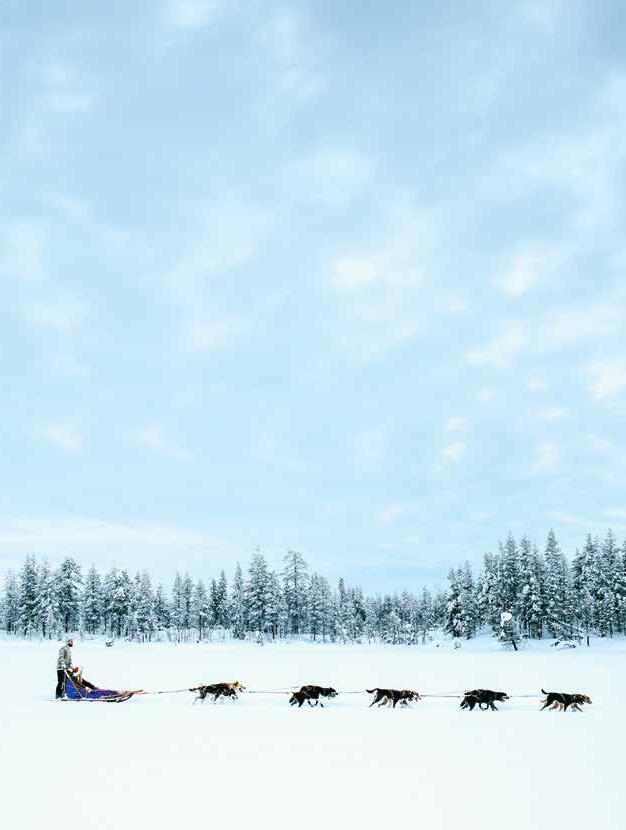
94 THE ARCTIC LIFESTYLE MAGAZINE
NATURE
Photo: Andy Anderson
In Junosuando, a village located on the Arctic Circle in Swedish Lapland, there’s a statue of Leonhard Seppala, one of the world’s most famous mushers. This is the story about Leonhard himself, his dog Togo, and what became known as “The Great Race of Mercy”.
on february 2, 1925, the Norwegian Gunnar Kaasen enters the town Nome as a hero with his dog sled team and lead dog Balto. He delivers ten kilos of vaccine to a town affected by the deadly epidemic diphtheria. Kaasen’s arrival marks the end of a week-long story in the world press, about a six-day dog-sled relay to the end of the world. Gunnar Kaasen and his dog Balto become the heroes of the event, those who are associated with the success. Balto even gets a statue in Central Park in New York, and Kaasen himself travels around on an exhibition tour for several years. But to other mushers and the general public, there were other, unsung heroes: they were called Leonhard and Togo and came from the north. They made an extraordinary and heroic effort under terribly harsh weather conditions. Altogether the two of them, plus their team of dogs, travelled for more than 400 kilometres through Alaska, through blizzards and cold, to save the people of their hometown.
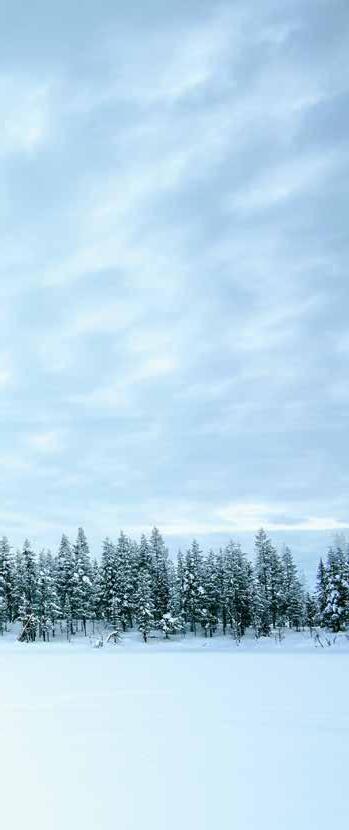
leonhard seppala, born 1877, would during those days go from being a good musher and just another hard working blue collar man to being the most famous dog-team driver in the world. His dog Togo would earn his place in the history books and a place at the Yale Peabody Museum.
Life with dogs was something Leonhard Seppala was born into, even if he didn’t know it himself until he got his first dogs. His dogs – not least his most famous dog, the lead dog Togo – soon realised that their master was made from different,
95
NATURE
sturdy stock. Togo gave his entire life to his musher. But we’ll get to that later.
Leonhard Seppala’s father was called Isak Seppälä and he came from Junosuando, on the Arctic Circle in Pajala municipality, in Swedish Lapland. The family moved to Norway and Leonhard emigrated to Alaska to dig for gold, something he soon gave up and started working as a musher to transport the gold instead.
togo was born in October 1913, lacking the physical attributes his musher believed were necessary to become a lead dog or even a good sled dog in the first place. As a puppy, he was sick and grew up to be almost impossibly stubborn and wilful. So Leonhard gave him away. The story about Togo escaping from his new owner by jumping straight through the glass pane of a closed window and then running back to his old home is a well-known one. Leonhard thought: “I guess he would rather stay here.” So be it.
But Togo didn’t make life easy for himself or his musher. Every time Leonhard took a team of dogs out, Togo escaped to join them. During these tours, he’d attack other lead dogs, in his mind to help his master. Once he attacked a large Alaskan malamute and was severely injured. After that, he never attacked another lead dog and Leonhard didn’t have to worry about confrontations with other teams again.
Eventually, on a trip where Togo had escaped to run next to the team and cause havoc, Leonhard had to harness him. Before that trip was over the little dog had advanced through the team and ended up next to the then lead dog, Russky. Togo ran for 120 kilometres on his first tour in a harness. Something that was unheard of among mushers at the time.
Leonhard Seppala commented: “I’d simply found a dog born to be a lead dog.” In a dog he thought would amount to nothing, a dog he’d tried to give away, he found what he’d been trying to breed for decades.
in january 1925 the deadly disease diphtheria had broken out in the coastal town of Nome, by the Pacific Ocean. Leonhard Seppala lived there with his family, and his eight-year-old daughter Sigrid was now in mortal danger because the vaccine available in town had expired and probably wouldn’t be enough in any case. The frozen town could only be saved if new serum arrived in time.
Already a month prior to the outbreak the provincial physician Curtis Welch in Nome had asked for a serum to be sent to the town. But collecting it took time, and the governing politicians probably delayed in deciding whether it was worth the money. The residents of Nome were mostly indigenous people. Reading Dr Welch’s telegram it seems perhaps they weren’t the highest priority, as the doctor concludes his emergency message with “There are 300 whites living in the area.” The new vaccine was on its way on the train from Anchorage, but when the train was due to depart the worst cold in the memory of living individuals had struck Alaska.
It was minus 50°C and the aircraft meant to carry supplies to Nome stood frozen on the ground. Instead, a relay of dog teams was to accept the mission. It normally took 30 days for a dog-sled team to travel between the towns Nome and Nenana. The record was nine days. Now they had to do it in six days to get there before the serum expired.
a relay involving 20 mushers and around 100 to 150 dogs was organized. It would be a trip of more than 1,000 kilometers through the interior of Alaska, in the merciless cold. The most difficult stretch was awarded a middle-aged man out of Tornedalen named Leonhard Seppala.
Leonhard Seppala and Togo were chosen to run the most unforgiving stretch. A 400-kilometre round trip, including among other things the deadly Norton Strait in minus 30°C through biting cold and hurricane-force
96 THE ARCTIC LIFESTYLE MAGAZINE
NATURE
“I never had a better dog than Togo. His stamina, loyalty and intelligence could not be improved upon. Togo was the best dog that ever travelled the Alaska trail.”
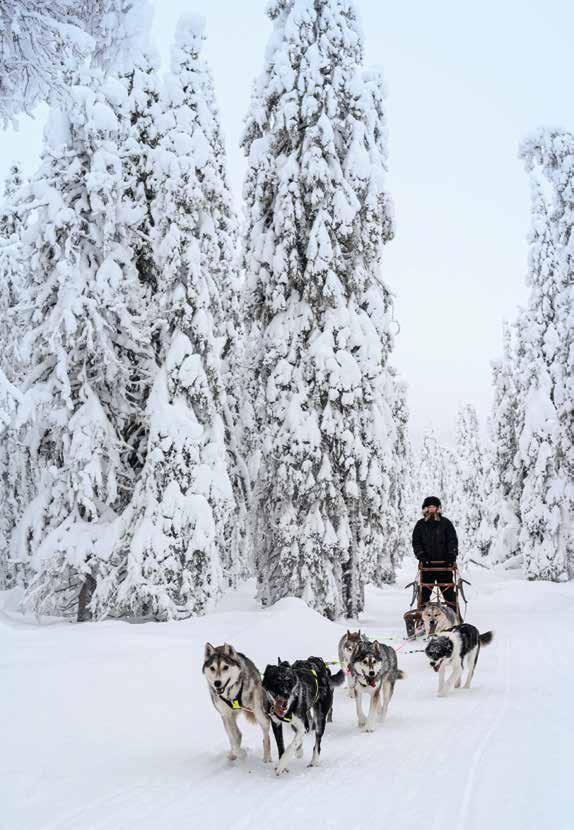
97 NATURE
Photo: Håkan Stenlund
winds. Always struggling against the clock. In perfect conditions, mushers had done the stretch Nenana to Nome in nine days, now they had to cut that with a third in the most unforgiving winter weather imaginable, to get the serum there in time.

When the relay started they all knew it was a matter of life and death. Telegraph operators worked incessantly and the entire world followed the heroes in “The great race of mercy”.
on january 27 the first musher, Wild Bill Shannon, picks up the serum at the train station in Nenana. It’s nine o’clock at night and outside it is minus 46°C. Wild Bill sets off straight away and the temperature drops even further. Wild Bill Shannon runs next to his team so he won’t freeze to death. It’s minus 52°C when he stops in Minto to catch a couple of hours’ rest. When he’s due to set off, three of his dogs have problems with their lungs and must be left behind. Wild Bill reaches Tolovana after 82 kilometres, his face severely frostbitten by the cold. There he hands the serum to Dan Green, who continues the journey once the serum has been warmed for a while. And so it continues.
When the temperature drops to -30°C a storm breaks out. It’s a frozen journey through the valley of death. People and dogs make an average of 50 kilometres at record times, despite all circumstances against them. They are heroes of their own world, coming to save a town basically on the outskirts of the world.
On January 31, Leonhard Seppala is given the serum by Henry Ivanoff just outside the village Shaktoolik. He’s already travelled more than 200 kilometres just to meet the other team. He must choose between
going around the Norton Strait, or straight across. The way round takes a whole day extra, so he chooses to go straight across. In the middle of the night, in darkness. He trusts his faithful Togo. The previous day a news reporter had written that: “The number of known diphtheria cases in Nome is now 27 and they’ve run out of serum. The dogs are their only hope.”
so seppala, who has already crossed the Norton Strait on his way to the rendezvous with the serum, knows that the conditions are terrible. With winds of up to 25 m/s, the sea ice is breaking up and there is open sea in many places. But as news reach him, about the serum running out and the town being almost lost, he chooses to fight the ice again. During the night and out on the ice, temperatures drop to minus 40°C and the wind increases further. It’s simply awful out there, on the rocking ice. And Leonhard can only trust his 12-year-old dog Togo.
Seppala reaches shore again on February 1 and leaves the sea ice behind. Togo has led the team and his musher to safety through darkness, cold and blizzards. They now ascend the pass at Little McKinley Mountain, a neat little climb of 1,500 metres, before they hand the serum to Charlie Olsen. By then Leonhard Seppala and Togo have managed 146 kilometres in a blizzard, across the Norton Strait and up a mountain pass, three times further than any of the other mushers during the relay.
The same day the 28th patient falls ill in Nome. The serum they are carrying is enough to treat 30 people, but on February 2, Gunnar Kaasen arrives with the serum in Nome and is received as a hero. Not a single bottle of the serum has been broken or lost.
The journey between Nenana and Nome was done in an amazing five and a half days through the worst possible weather. In total Leonhard Seppala and his lead-dog, Togo, had travelled more than 400 kilometres to save their city and their family.
another driver was meant to do the last stretch of the relay, but Kaasen drove past the house where he was resting. Some say he did it to secure his status as hero and media favourite. Certainly, Leonhard could never handle that Kaasen’s dog Balto became a hero.
98 THE ARCTIC LIFESTYLE MAGAZINE
When the statue was erected in Central Park the old
Photo: Ted Logart
NATURE
The statue of Leonhard Seppala, his wife Constance and his dogs in the town of Junosuando.
Tornedalen descendant said: “It was almost more than I could stand, when that farce of a dog was made into a statue.” But Seppala and Togo both got their share of the attention. They performed in Madison Square Garden, did adverts for Lucky Strike, and polar explorer Roald Amundsen gave Togo a medal.
These days the Iditarod race is run in memory of these fantastic heroes and among the dog sled drivers around the world Leonhard Seppala, hailing from Junosuando, is the world’s best dog sled driver, and his dog Togo is the best lead dog to ever have run the face of the earth. And of course, from the kennel of Leonhard Seppala, some dogs who now run the trails

of Swedish Lapland, also has the same heritage.
For instance in Särkimukka, at Explore the North, just minutes away from Leonhard Seppalas statue in Junosuando, a dog named Togo is running in a team. His forefather is Kusku, a dog taken from Alaska in the 1970s, from the same strain as the original Togo. But at the moment it’s a bit unclear if this Togo have the right carachter for being a lead-dog.
On December 5, 1929, Togo dies, 16 years old, and Leonhard Seppala mourns: “I never had a better dog than Togo. His stamina, loyalty and intelligence could not be improved upon. Togo was the best dog that ever travelled the Alaska trail.”
99
NATURE
Photo: Ted Logart
the weather report: One good word to know in Swedish is “bakslag”. It is usually experienced when you believe it will be spring, summer, fall, or winter, but all of a sudden it changes to a different season. Like when you take the boat out in spring to go pike fishing, and it becomes winter again. But in the end, you will get there.
Can’t
For more of the Arctic you can join swedishlapland on: facebook, instagram, steller, twitter, youtube, vimeo or just www.swedishlapland.com
Photo: Per Lundström

www.swedishlapland.com
Share your #swedishlaplandexperiences: get enough?



























































































































































